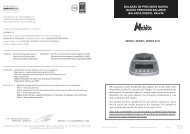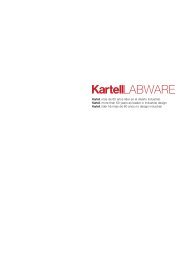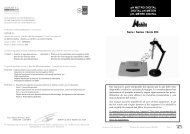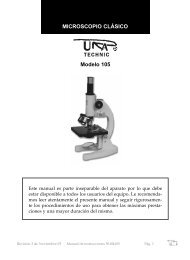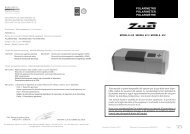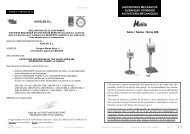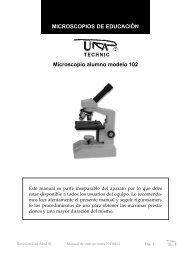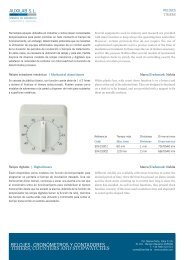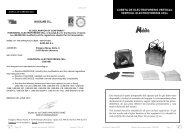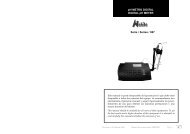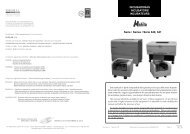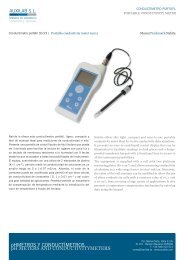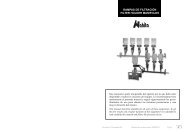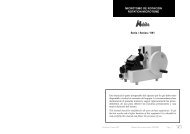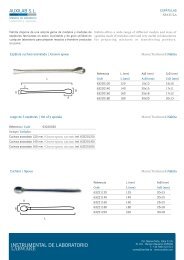auxilab sl microscopio de educación education microscope serie ...
auxilab sl microscopio de educación education microscope serie ...
auxilab sl microscopio de educación education microscope serie ...
You also want an ePaper? Increase the reach of your titles
YUMPU automatically turns print PDFs into web optimized ePapers that Google loves.
ANEX I: CE CERTIFICATE<br />
ENGLISH<br />
MICROSCOPIO DE EDUCACIÓN<br />
EDUCATION MICROSCOPE<br />
AUXILAB S.L.<br />
CE DECLARATION OF CONFORMITY<br />
ZUZI MICROSCOPE SERIES 128 of AUXILAB, S.L. for the Directive of Machines<br />
(89/392/CEE modified) and the regulations adopted for their transposition<br />
SERIE SERIES 128<br />
NAME OF THE MANUFACTURER / IMPORTER:<br />
AUXILAB, S.L.<br />
ADDRESS: Polígono Morea Norte, 8<br />
31191 Beriáin (Navarra)<br />
WE STATE THAT:<br />
ZUZI MICROSCOPE SERIES 128<br />
CODES 50128000, 50128001, 50128002, 50128022<br />
Are <strong>de</strong>signed and manufactured according to:<br />
• Directive 89/392/CEE, including the modifications and the national regulations<br />
that transpose them.<br />
• Directive 73/23/CEE modified over the electric security.<br />
• Directive 89/336/CEE modified over the electromagnetic compatibility.<br />
And that the following harmonized rules have been applied (or part of them):<br />
UNE 292-1, UNE 292-2, UNE 292-2/A1, UNE 614-1, UNE 1050, UNE 294,<br />
UNE 894-1, UNE 894-2, UNE 60204, UNE 61010-1.<br />
BERIAIN 4th DECEMBER 2007<br />
Signed by: ALFONSO AINCIBURU SANZ<br />
DIRECTOR/MANAGER<br />
Polígono Morea Norte, 8 31191 Beriain (Navarra) - Spain. Tel. 948 310 513 Fax 948 312 071<br />
Internet: www.<strong>auxilab</strong>.es · Email: correo@<strong>auxilab</strong>.es<br />
Page 32 Instruction manual 50128xxx Version 2 December-07<br />
Este manual es parte inseparable <strong>de</strong>l aparato por lo que <strong>de</strong>be estar<br />
disponible a todos los usuarios <strong>de</strong>l equipo. Le recomendamos leer<br />
atentamente el presente manual y seguir rigurosamente los procedimientos<br />
<strong>de</strong> uso para obtener las máximas prestaciones y una<br />
mayor duración <strong>de</strong>l mismo.<br />
This manual should be available for all users of these equipments. To get<br />
the best results and a higher duration of this equipment it is advisable to<br />
read carefully this manual and follow the processes of use.<br />
Revisión 2 Diciembre-2007 Manual <strong>de</strong> instrucciones 50128xxx Pág. 1
CASTELLANO<br />
Gracias por haber adquirido este equipo. Deseamos sinceramente que disfrute <strong>de</strong>l<br />
<strong>microscopio</strong> <strong>de</strong> educación Zuzi <strong>serie</strong> 128. Le recomendamos que cui<strong>de</strong> el equipo conforme<br />
a lo expuesto en este manual.<br />
Zuzi <strong>de</strong>sarrolla sus productos según las directrices <strong>de</strong>l marcado CE y haciendo hincapié<br />
en la ergonomía y seguridad <strong>de</strong>l usuario.<br />
La calidad <strong>de</strong> los materiales empleados en la fabricación y el correcto proce<strong>de</strong>r le permitirán<br />
disfrutar <strong>de</strong>l equipo por muchos años.<br />
El uso incorrecto o in<strong>de</strong>bido <strong>de</strong>l equipo pue<strong>de</strong> dar lugar a acci<strong>de</strong>ntes, <strong>de</strong>scargas eléctricas,<br />
cortocircuitos, fuegos, lesiones, etc. Lea el punto <strong>de</strong> Mantenimiento, don<strong>de</strong> se recogen<br />
aspectos <strong>de</strong> seguridad.<br />
LEA DETALLADAMENTE ESTE MANUAL DE INSTRUCCIONES ANTES DE OPE-<br />
RAR CON ESTE EQUIPO CON EL FIN DE OBTENER LAS MÁXIMAS PRESTACIONES<br />
Y UNA MAYOR DURACIÓN DEL MISMO.<br />
Tenga especialmente presente lo siguiente:<br />
• Este manual es parte inseparable <strong>de</strong>l <strong>microscopio</strong> <strong>de</strong> educación Zuzi <strong>serie</strong> 128, por lo<br />
que <strong>de</strong>be estar disponible para todos los usuarios <strong>de</strong>l equipo.<br />
• Debe manipularse siempre con cuidado evitando los movimientos bruscos, golpes, caídas<br />
<strong>de</strong> objetos pesados o punzantes; evite el <strong>de</strong>rrame <strong>de</strong> líquidos en su interior<br />
• Nunca <strong>de</strong>smonte el equipo para repararlo usted mismo, a<strong>de</strong>más <strong>de</strong> per<strong>de</strong>r la garantía<br />
podría producir un funcionamiento <strong>de</strong>ficiente <strong>de</strong> todo el equipo, así como daños a las personas<br />
que lo manipulan.<br />
• Para prevenir fuego o <strong>de</strong>scargas eléctricas, evite los ambientes secos y polvorientos. Si<br />
esto ocurre, <strong>de</strong>senchufe inmediatamente el equipo <strong>de</strong> la toma <strong>de</strong> corriente.<br />
• Cualquier duda pue<strong>de</strong> ser aclarada por su distribuidor (instalación, puesta en marcha,<br />
funcionamiento). Usted pue<strong>de</strong> también mandarnos sus dudas o sugerencias a la siguiente<br />
dirección <strong>de</strong> correo <strong>de</strong>l Servicio Técnico Zuzi (asistencia@<strong>auxilab</strong>.es) o bien llamando al<br />
Tel: 807117040 (0.30 Euros/min).<br />
• Este equipo está amparado por la Ley <strong>de</strong> garantías y bienes <strong>de</strong> consumo (10/2003).<br />
• No se consi<strong>de</strong>ran en garantía las revisiones <strong>de</strong>l equipo.<br />
• La manipulación <strong>de</strong>l equipo por personal no autorizado provocará la pérdida total <strong>de</strong><br />
la garantía.<br />
• Los fusibles (1 A) o accesorios, así como la pérdida <strong>de</strong> los mismos, no están cubiertos<br />
por dicha garantía. Tampoco estarán cubiertos por el periodo <strong>de</strong> garantía las piezas en su<br />
<strong>de</strong>sgaste por uso natural.<br />
• Asegúrese <strong>de</strong> guardar la factura <strong>de</strong> compra para tener <strong>de</strong>recho <strong>de</strong> reclamación o prestación<br />
<strong>de</strong> la garantía. En caso <strong>de</strong> enviar el equipo al Servicio Técnico adjunte factura o<br />
copia <strong>de</strong> la misma como documento <strong>de</strong> garantía.<br />
• Rellene y envíe la garantía antes <strong>de</strong> los 15 días <strong>de</strong>spués <strong>de</strong> la compra.<br />
• El fabricante se reserva los <strong>de</strong>rechos a posibles modificaciones y mejoras sobre este<br />
manual y equipo.<br />
¡ATENCIÓN! NO SE ADMITIRÁ NINGÚN APARATO PARA REPARAR QUE<br />
NO ESTÉ DEBIDAMENTE LIMPIO Y DESINFECTADO.<br />
ENGLISH<br />
• Check the prepared <strong>sl</strong>i<strong>de</strong> is not the other way round and check also the <strong>sl</strong>i<strong>de</strong>'s thickness,<br />
which has to have a standard thickness of 0.17 mm.<br />
If the <strong>sl</strong>i<strong>de</strong> <strong>sl</strong>ips un<strong>de</strong>r the mechanical stage:<br />
• Adjust the distance between the mechanical section and the stage with the screws located<br />
on the rear part of the mechanical stage (the screws have a standard size), making sure<br />
there is enough space to avoid the <strong>sl</strong>i<strong>de</strong> passing through and obtain a smooth movement<br />
without scratching the stage. Once it is properly adjusted notice you should not hold the<br />
<strong>microscope</strong> by the mechanical stage, as its weight could loosen the equipment. In case the<br />
problem persists send the equipment to Zuzi Technical Assistance Department through<br />
your distributor.<br />
8. TROUBLESHOOTING<br />
• As the head is rotary you should rather observe by the stage's frontal part, as it facilitates<br />
access to the mechanical control knobs.<br />
• Use of the immersion objective:<br />
- To use all the numerical aperture of the immersion objective (100x), add a drop of immersion<br />
oil in the space between the objective and the <strong>sl</strong>i<strong>de</strong>. Proceed as follows:<br />
- Focus the sample with a lower magnifying objective (40x) and put it in the centre of<br />
the field of view. This is essential because it is very difficult to find structures with the immersion<br />
objective.<br />
- Turn <strong>sl</strong>ightly the nosepiece so as no objective stays over the <strong>sl</strong>i<strong>de</strong>.<br />
- Add a drop of immersion oil over the region of the sample to be observed.<br />
- Turn completely the nosepiece and put the immersion objective over the <strong>sl</strong>i<strong>de</strong> (both<br />
the sample and the objective lens must be in contact with the immersion oil). Adjust focusing<br />
with the fine adjustment knob.<br />
- Avoid the appearance of bubbles in the oil film, since it spoils the resulting image.<br />
- After each observation, clean the objective lens with a special lens tissue to remove the rests<br />
of immersion oil. Never let the oil dry on the lens.<br />
NOTE: never submerge the objective in any liquid nor use solvents such as xylol or toluene<br />
for cleaning, since it may provoke the <strong>de</strong>tachment of the lens.<br />
• Handling the stage: First, move the sample in consecutive steps, from the front to the back;<br />
each fraction is observed to <strong>de</strong>tail by means of a lateral movement. Thus, the sample can be<br />
moved in a uniform way and so explore all its area.<br />
INSTRUCTIONS ON ENVIRONMENTAL PROTECTION<br />
Do not dispose of this product in the usual household garbage at the end of its life<br />
cycle; hand it over at a collection point for the recycling of electrical and electronic<br />
appliances. The symbol on the product, the instructions for use or the packing will<br />
inform about the methods for disposal.<br />
The materials are recyclable as mentioned in its marking. By recycling, material recycling or<br />
other forms or re-utilization of old appliances, you are making an important contribution to protect<br />
our environment.<br />
Please inquire at the community administration for the authorized disposal location.<br />
Pág. 2 Manual <strong>de</strong> instrucciones 50128xxx Revisión 2 Diciembre-07<br />
Version 2 December-07 Instruction manual 50128 Page 31
ENGLISH<br />
there is not any diffuser filter.<br />
• Eyepieces are well fit and objectives well screwed.<br />
• Eyepieces and objectives are perfectly cleaned and free of particles. To check cleaning of<br />
the whole optical system proceed as follows:<br />
a) Make the eyepieces turn checking the little specks are moving; if so, clean<br />
them. Make the head turn. You should never disassemble the head, but you can clean it<br />
with <strong>de</strong>licacy by blowing the accessible surfaces of prisms with a plastic bulb.<br />
b) Turn the objective and, in case the parasite images also turn, clean it with the<br />
help of a dry brush to remove the dust. Watch the front part of the <strong>microscope</strong> with a magnifying<br />
glass or an inverted eyepiece.<br />
• There is enough immersion oil and it does not contain bubbles or impurities.<br />
• Thickness of <strong>sl</strong>i<strong>de</strong>s, cover glasses and means of assembly is not too much as to avoid<br />
focusing with medium or high magnification (there are standard sizes for both the <strong>sl</strong>i<strong>de</strong>s<br />
and cover glasses). Sli<strong>de</strong>s and cover glasses should be clean. Check that the <strong>sl</strong>i<strong>de</strong> is properly<br />
located and there are not two cover glasses superimposed.<br />
- The combination objective-eyepiece is appropriate; the eyepiece can be too<br />
powerful for the selected objective.<br />
- The prepared <strong>sl</strong>i<strong>de</strong> is well done; check it with a "test" prepared <strong>sl</strong>i<strong>de</strong>.<br />
8. TROUBLESHOOTING<br />
Before sending the <strong>microscope</strong> back to Zuzi Technical Assistance Department, check the<br />
following:<br />
If the lamp does not switch on:<br />
Check it is properly connected to the right current intake.<br />
Check both fuse and lamp are in good conditions. If not, replace the fuse or the lamp.<br />
If the field of vision is cut:<br />
• Check the nosepiece is properly fit. To do that, turn it <strong>sl</strong>ightly back and forth until it fits.<br />
Check it is well centred and if not, send it to Zuzi Technical Assistance Department<br />
through your distributor.<br />
If there is dust or dirt in the field of view:<br />
• Check there is dust on the precon<strong>de</strong>nser lens, upper lens of the con<strong>de</strong>nser or the eyepiece,<br />
as well as the cleanliness of the sample. Once you find out where the dirt is, clean<br />
it as explained before.<br />
If an area in the field of view is out of focus:<br />
• Check the objective is properly located on the luminous beam's path. If not, turn it until<br />
it is in an appropriate position.<br />
• Check the sample is properly located on the stage, making sure it is held by the stage<br />
clips. Then, if it does not focus revise the coarse adjustment knob.<br />
If the frontal lens of the objective touches the prepared <strong>sl</strong>i<strong>de</strong> when focusing:<br />
• Check the prepared <strong>sl</strong>i<strong>de</strong> is not the other way round (being the <strong>sl</strong>i<strong>de</strong> over the cover<br />
glass) and placing it properly in case it is appropriate to do so.<br />
If the frontal lens of the more powerful objective touches the prepared <strong>sl</strong>i<strong>de</strong> when passing from<br />
a low-magnification objective to a superior one:<br />
Page 30 Instruction manual 50128xxx Version 2 December-07<br />
ÍNDICE DE IDIOMAS<br />
Castellano<br />
Inglés<br />
ÍNDICE DE CONTENIDOS<br />
1. APLICACIONES DEL INSTRUMENTO<br />
2. DESCRIPCIÓN<br />
3. ESPECIFICACIONES TÉCNICAS<br />
4. INSTALACIÓN / PUESTA EN MARCHA<br />
5. MANTENIMIENTO Y LIMPIEZA<br />
6. ELECCION DE OBJETIVOS Y OCULARES<br />
7. CAUSAS DE UNA MALA IMAGEN<br />
8. LOCALIZACION DE AVERIAS<br />
9. RECOMENDACIONES PRÁCTICAS<br />
ANEXO I: CERTIFICADO CE<br />
1. APLICACIONES DEL INSTRUMENTO<br />
Revisión 2 Diciembre-2007 Manual <strong>de</strong> instrucciones 50128xxx Pág. 3<br />
2-17<br />
18-32<br />
Su avanzado y mo<strong>de</strong>rno diseño, así como la configuración modular, hacen <strong>de</strong> este<br />
<strong>microscopio</strong> una herramienta imprescindible y <strong>de</strong> fácil manejo para laboratorios <strong>de</strong> educación<br />
en cualquier tipo <strong>de</strong> enseñanza.<br />
2. DESCRIPCIÓN<br />
1. Ocular<br />
2. Cabezal giratorio<br />
3. Objetivos<br />
4. Estativo<br />
5. Tornillo tope enfoque<br />
6. Mando <strong>de</strong> enfoque macrométrico<br />
7. Mando <strong>de</strong> enfoque micrométrico<br />
8. Platina<br />
9. Pinzas<br />
11. Con<strong>de</strong>nsador con diafragma iris<br />
12. Precon<strong>de</strong>nsador<br />
13. Interruptor<br />
14. Regulador <strong>de</strong> intensidad <strong>de</strong> luz<br />
9<br />
8<br />
10<br />
3 4<br />
5<br />
11<br />
12<br />
CASTELLANO<br />
2<br />
1<br />
6<br />
7<br />
13<br />
3<br />
3<br />
4<br />
6<br />
13<br />
14<br />
14<br />
15<br />
16<br />
17
3. ESPECIFICACIONES TÉCNICAS<br />
Referencia 50128000 50128001 50128002 50128022<br />
Mo<strong>de</strong>lo 128 128/1 128/2 128/22<br />
Cabezales Monocular Monocular Monocular Binocular<br />
Oculares WF10x WF10x WF10x WF10x<br />
Revólver Triple Cuádruple<br />
Objetivos Acromáticos Acromáticos<br />
4x,10x,40x (R)<br />
4x,10x,40x (R),100x (R)(I)<br />
Enfoque<br />
Macro y micro in<strong>de</strong>pendientes<br />
Platina Con pinzas Con carro mecánico<br />
Con<strong>de</strong>nsador Fijo <strong>de</strong> lente Abbe A.N. 1.25 Abbe A.N. 1.25 Abbe A.N. 1.25<br />
simple A.N. 0.65<br />
Diafragma<br />
Iris<br />
Iluminación<br />
Halógena 6 V, 20W<br />
Cabezal<br />
Dependiendo <strong>de</strong>l mo<strong>de</strong>lo:<br />
- Monocular, inclinado 45º y giratorio 360º<br />
- Binocular, inclinado 45º y giratorio 360º. Con regulación <strong>de</strong> distancia interpupilar por<br />
mecanismo libre y corrección dióptrica en uno <strong>de</strong> los portaoculares.<br />
Longitud mecánica <strong>de</strong>l tubo<br />
- 160 mm<br />
Estativo<br />
- Metálico, muy estable, con mandos para enfoque macro y micrométrico in<strong>de</strong>pendientes<br />
Recorrido <strong>de</strong>l enfoque<br />
- Macro: 30 mm con parada final<br />
- Micro: 30 mm, 0-200 micras en 2 micras<br />
Revólver<br />
Dependiendo <strong>de</strong>l mo<strong>de</strong>lo:<br />
- Triple, giratorio en ambos sentidos<br />
- Cuádruple, giratorio en ambos sentidos<br />
Platina<br />
Dependiendo <strong>de</strong>l mo<strong>de</strong>lo:<br />
- Platina fija (120x120 mm) con pinzas<br />
- Platina fija (120x120 mm) con carro mecánico. Recorrido 60x30 mm.<br />
Con<strong>de</strong>nsador<br />
Situado <strong>de</strong>bajo <strong>de</strong> la platina, permite concentrar la luz en la muestra que se observa.<br />
Dependiendo <strong>de</strong>l mo<strong>de</strong>lo:<br />
Pág. 4 Manual <strong>de</strong> instrucciones 50128xxx Revisión 2 Diciembre-07<br />
CASTELLANO<br />
ENGLISH<br />
voke malfunction.<br />
• Please use the plastic cover provi<strong>de</strong>d to keep the <strong>microscope</strong> away from dust lying on<br />
the optical parts when it is not used for a long period of time.<br />
• Please keep the original packaging either to transport the equipment, when it is not<br />
being used for a long time or when you send it for an overhaul.<br />
Cleaning<br />
NOTE: Zuzi recommends using the <strong>microscope</strong> cleaner kit (co<strong>de</strong> 89000001).<br />
• Never use scourers or substances that can grate for cleaning metallic parts such as stainless<br />
steel, aluminium, coatings, etc. as they damage the <strong>microscope</strong> and produce an early<br />
ageing of the equipment.<br />
• Use a fluff-free cloth dampened with soaped water that does not contain abrasives.<br />
• Lenses must not be disassembled by the user. Were there any dust or dirt to be cleaned,<br />
clean it with a natural horse hair brush or a smooth piece of cloth, fluff-free, dampened<br />
with a bit of xilol or toluene.<br />
• To remove dust from lenses, blow them with a plastic bulb or clean them with a natural<br />
horsehair brush.<br />
• When cleaning mechanical or plastic parts do not use abrasive solvents that could<br />
damage either paint or finish. Always use neutral <strong>de</strong>tergents.<br />
ATTENTION!! IF EQUIPMENTS ARE NOT PROPERLY CLEAN AND DISIN-<br />
FECTED THEY WOULD NOT BE ALLOWED TO REPAIR BY OUR TECHNICAL<br />
SERVICE.<br />
6. CHOOSING OBJECTIVES AND EYEPIECES<br />
Zuzi <strong>microscope</strong>s <strong>serie</strong>s 128 are supplied with WF10x eyepieces and with 4x, 10x, 40x<br />
and 100x achromatic objectives, but can be used with other eyepieces and objectives. To<br />
know our offer of eyepieces and objectives look up our catalogue or visit our web page<br />
(www.<strong>auxilab</strong>.com).<br />
The observed image loses surface and sharpness as magnification increases. The mentioned<br />
increase should be done by changing objectives and putting each time a more<br />
powerful one and not by changing eyepieces to a higher magnification, as eyepieces only<br />
magnify the image obtained with the objective. Thus, the more magnification the eyepiece<br />
has, the higher will be the loss of sharpness, clarity and surface of the resulting image.<br />
For routine observations use the eyepiece with lesser magnification with more powerful<br />
objectives. The eyepiece with the higher magnification should be kept back for particular<br />
occasions, bearing in mind that it <strong>de</strong>creases <strong>de</strong>finition and does not increase resolution.<br />
7. CAUSES OF A DEFECTIVE IMAGE<br />
In case of a <strong>de</strong>fective image check the following:<br />
• Illumination is well done and luminous intensity is neither excessive nor too weak.<br />
Never adjust it with the con<strong>de</strong>nser's diaphragm. Both the con<strong>de</strong>nser and the lamp should<br />
be well centred. Check that between the field diaphragm and the aperture diaphragm<br />
Version 2 December-07 Instruction manual 50128 Page 29
ENGLISH<br />
Security<br />
• The <strong>microscope</strong> must be used by previou<strong>sl</strong>y qualified staff that knows how the equipment<br />
works thanks to the user manual.<br />
• Put the <strong>microscope</strong> on top of a horizontal, plane, stable table, having a safety area of at<br />
least 30 cm per si<strong>de</strong>.<br />
• Do not place the <strong>microscope</strong> near any warm supply (burners, blowlamps, etc), nor<br />
expose it directly to the sun. Avoid vibrations, dust and dry environments.<br />
• During operation dangerous materials such as flammable or pathological substances<br />
must be out of the safety area.<br />
• When you are not using the <strong>microscope</strong> for a long period of time please make sure it is<br />
unplugged in or<strong>de</strong>r to avoid possible acci<strong>de</strong>nts.<br />
• It is essential to have the equipment switched off and unplugged from the net before<br />
cleaning, checking components or replacing any piece (e.g. replacement of a fuse).<br />
• Never try to repair the <strong>microscope</strong> by yourself, since you will lose the warranty and<br />
may provoke damages to the general operating system or the electrical installation, as<br />
well as injuries to the people that usually handle the equipment (burns, hurts…).<br />
• Ma<strong>de</strong> un<strong>de</strong>r the European regulations for electrical security, electromagnetic compatibility<br />
and security on machines.<br />
5. MAINTENANCE AND CLEANING<br />
To get the best results and a higher duration of this <strong>microscope</strong> it is essential to<br />
follow the processes of use.<br />
Note: All the processes of use mentioned below will not have any value unless you keep<br />
a continued and careful maintenance.<br />
• Please follow the processes of use of this manual.<br />
• This manual should be available for all users of this equipment.<br />
• Always use original components and supplies. Other <strong>de</strong>vices can be similar but they<br />
can damage the equipment.<br />
• The <strong>microscope</strong> is supplied with a Schuko standard wire. It has to be plugged to an<br />
earth connection and the socket should be handy and ready to unplug the equipment in<br />
case of emergency.<br />
• Never try to repair the <strong>microscope</strong> by yourself, since you will lose the warranty and<br />
may provoke damages to the general operating system or the electrical installation, as<br />
well as injuries to the people that usually handle the equipment (burns, hurts…) or damages<br />
in nearby equipments.<br />
• In the event of breakdown please contact your distributor to overhaul through Zuzi<br />
Technical Assistance Department.<br />
• In case the lamp blows up, replace it for another one, making sure it is a 6 V 20 W Zuzi<br />
original one. Please take care and do not touch the lamp with bare hands. Do not use<br />
lamps with a higher power, as they could provoke over heating or any malfunction.<br />
IMPORTANT: Before replacing the lamp make sure the <strong>microscope</strong> is disconnected<br />
from the electric intake. Check you are using the proper lamps, as other types can pro-<br />
CASTELLANO<br />
- Con<strong>de</strong>nsador fijo <strong>de</strong> lente simple (A.N. 0.65), con diafragma iris y portafiltros móvil<br />
(incluye filtro ver<strong>de</strong> 32 mm Ø)<br />
- Con<strong>de</strong>nsador Abbe (A.N. 1.25) regulable en altura, con diafragma iris y portafiltros<br />
móvil (incluye filtro ver<strong>de</strong> <strong>de</strong> 32 mm Ø)<br />
Diafragma iris<br />
- Está situado <strong>de</strong>bajo <strong>de</strong> la platina y <strong>de</strong>l con<strong>de</strong>nsador, siendo el encargado <strong>de</strong> regular la<br />
entrada <strong>de</strong> luz al con<strong>de</strong>nsador.<br />
Iluminador<br />
- Halógeno <strong>de</strong> baja tensión con lámpara halógena 6 V 20 W, alimentador incorporado<br />
(220 V, 50 Hz ± 10%), interruptor y potenciómetro <strong>de</strong> control <strong>de</strong> intensidad.<br />
Embalaje<br />
- Funda protectora <strong>de</strong> plástico - Caja <strong>de</strong> cartón con protecciones para envío<br />
- Mol<strong>de</strong> <strong>de</strong> poliestireno expandido<br />
Especificaciones ópticas<br />
- Objetivos acromáticos: a la hora <strong>de</strong> trabajar con los objetivos, se pue<strong>de</strong> hablar <strong>de</strong> objetivos<br />
secos, que son aquellos en los que entre el objetivo y la preparación sólo hay aire; y<br />
<strong>de</strong> objetivos <strong>de</strong> inmersión, cuando es necesario colocar entre la lente y la preparación un<br />
aceite <strong>de</strong> inmersión que permite una mayor luminosidad.<br />
Los <strong>microscopio</strong>s Zuzi <strong>serie</strong> 128 disponen se suministran con tres objetivos secos (4x,<br />
10x y 40x) y un objetivo <strong>de</strong> inmersión (100x, sólo mo<strong>de</strong>los 128/2 y 128/22). A<strong>de</strong>más, los<br />
objetivos <strong>de</strong> 40x y 100x son retráctiles (R), es <strong>de</strong>cir, están provistos <strong>de</strong> un mecanismo que<br />
hace que el objetivo se retraiga si entra en contacto con la muestra y <strong>de</strong> esta manera evita<br />
que se produzcan daños tanto en el propio objetivo como en la preparación.<br />
Las características <strong>de</strong> cada objetivo están codificadas por una <strong>serie</strong> <strong>de</strong> marcas grabadas<br />
en el propio objetivo, <strong>de</strong> la siguiente manera:<br />
40: Aumento <strong>de</strong>l objetivo<br />
0.65: Apertura numérica (A.N.)<br />
160: Longitud <strong>de</strong>l tubo<br />
0.17: Espesor <strong>de</strong>l cubreobjetos<br />
Aumento 4x 10x 20x* 40x (R) 60x (R)* 100x(R)(I)<br />
Distancia <strong>de</strong> trabajo (mm) 37.50 7.32 1.26 0.63 0.41 0.19<br />
Apertura numérica 0.10 0.25 0.40 0.65 0.85 1.25<br />
(R) Retráctil (I) Inmersión * Opcional<br />
- Oculares: están formados por dos lentes que se encuentran separados por un diafragma.<br />
Su misión es llevar la imagen <strong>de</strong>s<strong>de</strong> el objetivo hasta el ojo.<br />
Tipo/aumento WF/10x WF/16x*<br />
Distancia focal 24.99 mm 15.58 mm<br />
Diámetro <strong>de</strong> campo 18 11 * Opcional<br />
Page 28 Instruction manual 50128xxx Version 2 December-07<br />
Revisión 2 Diciembre-2007 Manual <strong>de</strong> instrucciones 50128xxx Pág. 5
CASTELLANO<br />
Aumentos totales: Es el resultado <strong>de</strong> multiplicar el aumento <strong>de</strong>l ocular por el aumento<br />
<strong>de</strong>l objetivo.<br />
Oculares Objetivos 4x 10x 20x* 40x(R) 60x(R)* 100X(R)(I)<br />
WF/10x Aumento total 40 100 200 400 600 1000<br />
Campo <strong>de</strong> visión (mm) 4.50 1.80 0.9 0.45 0.30 0.18<br />
WF/16x* Aumento total 64 160 320 640 960 1600<br />
Campo <strong>de</strong> visión (mm) 2.75 1.10 0.55 0.27 0.18 0.11<br />
(R) Retráctil (I) Inmersión * Opcional<br />
- Apertura numérica: <strong>de</strong>termina las propieda<strong>de</strong>s <strong>de</strong>l objetivo. La apertura numérica más<br />
gran<strong>de</strong> hace la imagen más brillante y la resuelve mejor. La apertura numérica <strong>de</strong>l objetivo<br />
siempre <strong>de</strong>berá ser menor o igual que la apertura numérica <strong>de</strong>l con<strong>de</strong>nsador.<br />
- Distancia <strong>de</strong> trabajo: distancia, en mm, entre la preparación y la lente frontal <strong>de</strong>l objetivo<br />
cuando el <strong>microscopio</strong> se encuentra enfocado.<br />
- Distancia focal: distancia <strong>de</strong>s<strong>de</strong> el plano principal imagen <strong>de</strong>l sistema hasta su foco<br />
imagen, expresada en mm.<br />
- Resolución: es el valor recíproco <strong>de</strong>l po<strong>de</strong>r separador, el cual representa la mínima distancia<br />
en la cual dos pequeñas partículas bajo la lente pue<strong>de</strong>n verse separadas.<br />
- Campo <strong>de</strong> visión: tamaño, en mm, <strong>de</strong>l campo real que estamos observando.<br />
4. INSTALACIÓN Y PUESTA EN MARCHA<br />
Inspección preliminar<br />
Desembale el <strong>microscopio</strong>, retire el plástico que lo envuelve y quite la protección <strong>de</strong><br />
poliespán en que viene encajado. Retire todas las protecciones y, sin conectar el equipo a<br />
la red eléctrica, asegúrese <strong>de</strong> que no presenta ningún daño <strong>de</strong>bido al transporte. De ser<br />
así, comuníquelo inmediatamente a su transportista o suministrador para que pueda<br />
hacer las <strong>de</strong>bidas reclamaciones en el plazo establecido.<br />
Guar<strong>de</strong> el embalaje, ya que siempre se <strong>de</strong>ben realizar las <strong>de</strong>voluciones en su embalaje<br />
original con todos los accesorios suministrados.<br />
Compruebe los accesorios que usted <strong>de</strong>be recibir junto al equipo:<br />
- Microscopio con cable <strong>de</strong> red - Kit <strong>de</strong> limpieza<br />
- Objetivos acromáticos (según mo<strong>de</strong>lo) - Funda <strong>de</strong> plástico<br />
- Ocular/es WF/10x - Manual <strong>de</strong> instrucciones<br />
- Filtro ver<strong>de</strong> - Certificado <strong>de</strong> garantía<br />
- Lámpara halógena (6 V, 20 W)<br />
- Fusible<br />
Solo aceptamos <strong>de</strong>voluciones <strong>de</strong> equipos en los 15 días posteriores al envío y siempre<br />
que vengan completos en su embalaje original.<br />
Instalación<br />
• Antes <strong>de</strong> comenzar a utilizar el equipo, es conveniente familiarizarse con sus componentes<br />
y fundamentos básicos, así como con las funciones <strong>de</strong> sus controles.<br />
ENGLISH<br />
• The stage must be properly centred; otherwise, when<br />
turning the stage the sample's object would be out of the<br />
Figure 8<br />
field of view. To centre a prepared <strong>sl</strong>i<strong>de</strong> it is necessary to<br />
start with few magnifications and engrave, either with<br />
ink or a diamond, a cross or a circle with 1 mm diameter.<br />
Then lace the sample in the middle of the stage, fix it with<br />
the holding clips and then turn the stage.<br />
• It is inevitable that the object gets out of the field of<br />
vision. As it must remain centred, you should move it<br />
with your hand. After sizing up it previou<strong>sl</strong>y, you have to<br />
turn the stage a complete turn without the object being<br />
out of the field of vision. In this moment you have to turn<br />
the nosepiece to a higher magnification making sure you follow the same steps; doing it<br />
as explained you will keep the sample centred with any optical arrangement.<br />
• Once the stage is centred and the turning sample is placed between the crossed polarizers,<br />
two cases can come up while observing:<br />
- If the sample disappears 4 times and appears another 4 times in positions that separate<br />
45º one from each other (which can be done and verified with the stage's graduated circle),<br />
we can state we have a birefringent material. Do not forget that with overly thin materials<br />
or <strong>sl</strong>ightly anisotropic ones, lighting must be extremely weak.<br />
- If the field of vision remains dark during all the time we are turning the sample, we<br />
can consi<strong>de</strong>r three different possibilities:<br />
- The structure is birefringent, but it is badly positioned. If its axis coinci<strong>de</strong>s<br />
with the <strong>microscope</strong>'s, it would be acting as if an isotropic object. In this case, relocate<br />
the object or replace the prepared <strong>sl</strong>i<strong>de</strong>.<br />
- The material is <strong>sl</strong>ightly birefringent, not enough to produce a luminous<br />
signal.<br />
- Finally, we can consi<strong>de</strong>r we have an isotropic object.<br />
3. Eyepiece vi<strong>de</strong>o cameras<br />
Co<strong>de</strong> Resolution Output<br />
59140052 640x480 pixels Composite vi<strong>de</strong>o<br />
59140060 640x480 pixels USB 2.0<br />
59150060 1280x1024 pixels USB 2.0<br />
4. Double head for <strong>de</strong>monstration (co<strong>de</strong> 90119910)<br />
This accessory allows two users to observe the sample at<br />
the same time.<br />
5.Eyepieces and objectives<br />
Eyepieces<br />
Co<strong>de</strong> Description<br />
90100104 Wi<strong>de</strong>field eyepiece WF/5x<br />
90100126 Wi<strong>de</strong>field eyepiece WF/16x<br />
Achromatic objectives<br />
Co<strong>de</strong> Magnification<br />
90100203 20x<br />
90100206 60x(R)<br />
Pág. 6 Manual <strong>de</strong> instrucciones 50128xxx Revisión 2 Diciembre-07<br />
Version 2 December-07 Instruction manual 50128 Page 27
ENGLISH<br />
Birefringence is a characteristic of certain substances that partially restore light when<br />
placed between two crossed polarizers, that is, they have double refraction (double refraction<br />
is known as the monochromatic light beam that makes differ two refracted beams<br />
when simultaneou<strong>sl</strong>y entering through certain materials).<br />
Uses of polarized light <strong>microscope</strong>s cover different fields such as the study of vitamins,<br />
starch or biological anisotropies; but studies of worn stones (crystal structures) until they<br />
constitute thin preparations are one of the most appealing applications. In these preparations<br />
constituent minerals are easily i<strong>de</strong>ntified by its crystals' shape, as well as thanks to<br />
the bright colours acquired when seen through crossed polarizers.<br />
There are some precautions to be taken when using this type of <strong>microscope</strong>s:<br />
• As a consequence of absorption phenomena produced in both polarizers a loss of light<br />
is caused, so it is convenient to avoid any odd light when using polarized light. Thus, it<br />
is recommen<strong>de</strong>d to use a large sheet of black paperboard (large enough to hi<strong>de</strong> the observer's<br />
head) as a protective screen.<br />
• In the case of tasks that require quite an accurate and meticulous work with <strong>sl</strong>ightly<br />
birefringent structures we should make sure neither <strong>sl</strong>i<strong>de</strong>s nor cover glasses present traces<br />
of birefringence; for this reason, we will previou<strong>sl</strong>y observe <strong>sl</strong>i<strong>de</strong>s and cover glasses<br />
with the stage and the analyzer.<br />
• For the study of dried up crystalline precipitates it is important to examine it in two<br />
parts: a part being dry and the other prepared with Canadian balsam, as it stands out better<br />
the interference colours. In this case it is advisable to have a little amount of balsam for<br />
some peripheral crystals to be in the air.<br />
To put the petrographic stage, proceed as follows:<br />
Figure 7<br />
• Remove the clips (mo<strong>de</strong>l 128) or the attachable mechanical<br />
stage (mo<strong>de</strong>ls 128/1, 128/2 and 128/22) supplied with<br />
c<br />
the fixed stage (Figure 5).<br />
• Put the petrographic stage on the fixed stage matching<br />
the holes of the petrographic stage with the holes marked<br />
as "c" in the fixed stage. Hold firmly the petrographic<br />
stage with the screws supplied (Figure 7).<br />
Put the analyzer supplied on the eyepiece (Figure 8).<br />
b<br />
•<br />
The <strong>microscope</strong> is ready to be used<br />
a<br />
To make a birefringence study proceed as follows:<br />
• Make the "0" of the rotary platform coinci<strong>de</strong> with the<br />
mark on the stage so as to read the rotating angle.<br />
• Put the analyzer on the eyepiece and, without placing<br />
any sample on the stage, turn the analyzer until observing<br />
a completely dark image (crossed polarizers). Please be<br />
careful and make sure you do not move the analyzer<br />
while observing, as the reading done would be entirely<br />
wrong.<br />
• Place the sample on the stage.<br />
• Focus the object.<br />
230<br />
220<br />
150 160 170 180 190 200 210<br />
140<br />
10 20 30<br />
130<br />
120<br />
40<br />
110<br />
50<br />
100<br />
60<br />
70<br />
90<br />
80<br />
LEA DETALLADAMENTE ESTE MANUAL DE INSTRUCCIONES ANTES DE OPE-<br />
RAR CON ESTE EQUIPO CON EL FIN DE OBTENER LAS MÁXIMAS PRESTACIONES<br />
Y UNA MAYOR DURACIÓN DEL MISMO.<br />
• Coloque el <strong>microscopio</strong> sobre una mesa horizontal, plana y estable, creando un espacio<br />
libre <strong>de</strong> al menos 30 cm por cada lado. No coloque el equipo en zonas próximas a fuentes<br />
<strong>de</strong> calor (mecheros, sopletes...), ni lo exponga directamente a la luz <strong>de</strong>l sol, etc.<br />
• MUY IMPORTANTE: Para su transporte, nunca coja el <strong>microscopio</strong> por la platina ni<br />
por el tubo ocular, ya que <strong>de</strong> esta manera todo el peso <strong>de</strong>l aparato <strong>de</strong>scansa sobre el tornillo<br />
micrométrico, y las partes mecánicas y <strong>de</strong> precisión son lentamente erosionadas.<br />
• Evite en el lugar <strong>de</strong> trabajo productos inflamables o tóxicos.<br />
• El observador <strong>de</strong>be adoptar una postura cómoda, bien sentado y con la espalda recta.<br />
Es conveniente trabajar sobre una mesa oscura a fin <strong>de</strong> eliminar toda luz parásita que<br />
pueda <strong>de</strong><strong>sl</strong>umbrar y disminuir la buena <strong>de</strong>finición <strong>de</strong> las imágenes, evitándose así una<br />
fatiga innecesaria.<br />
• Utilice la funda <strong>de</strong> plástico <strong>de</strong>l <strong>microscopio</strong> siempre que este no esté en uso para evitar<br />
que el polvo se pose sobre las partes ópticas.<br />
• Cuando no vaya a hacer uso <strong>de</strong>l <strong>microscopio</strong> durante largos períodos <strong>de</strong> tiempo, asegúrese<br />
<strong>de</strong> que está <strong>de</strong>sconectado <strong>de</strong> la red y protéjalo <strong>de</strong>l polvo (evitando así posibles acci<strong>de</strong>ntes<br />
y prolongando la vida útil <strong>de</strong>l equipo).<br />
Puesta en funcionamiento<br />
Figura 2<br />
• Haga bajar la platina mediante los mandos <strong>de</strong> enfoque<br />
macro. Enrosque los objetivos en el revólver <strong>de</strong> manera<br />
que sigan un or<strong>de</strong>n ascen<strong>de</strong>nte (4x-10x-40x) cuando el<br />
revólver sea girado en el sentido <strong>de</strong> las agujas <strong>de</strong>l reloj<br />
(Figura 2).<br />
• El <strong>microscopio</strong> se suministra con el/los ocular/es ya<br />
4X<br />
colocados. Si necesita cambiar <strong>de</strong> oculares, afloje el pequeño<br />
tornillo situado en el tubo ocular <strong>de</strong>l <strong>microscopio</strong> cambie<br />
el ocular y fíjelo <strong>de</strong> nuevo ajustando el tornillo<br />
(Figura 3). El cabezal se coloca normalmente en dirección<br />
al frente <strong>de</strong>l <strong>microscopio</strong>, pero si fuese necesario pue<strong>de</strong><br />
colocarlo en cualquier otra posición ya que pue<strong>de</strong> ser girado<br />
en un ángulo <strong>de</strong> 360º.<br />
• Los <strong>microscopio</strong>s Zuzi <strong>serie</strong> 128 se suministran con un cable <strong>de</strong> red Schuko. Inserte el<br />
cable <strong>de</strong> alimentación <strong>de</strong> corriente alterna (CA) a la base <strong>de</strong> corriente provista <strong>de</strong> toma a<br />
tierra. La unidad acepta una tensión <strong>de</strong> 220 V, 50 Hz ± 10%.<br />
Ni el fabricante ni el distribuidor asumirán responsabilidad alguna por los daños<br />
ocasionados al equipo, instalaciones o lesiones sufridas a personas <strong>de</strong>bido a la inobservancia<br />
<strong>de</strong>l correcto procedimiento <strong>de</strong> conexión eléctrica. La tensión <strong>de</strong>be ser <strong>de</strong> 220<br />
V, 50 Hz ± 10%.<br />
10X<br />
CASTELLANO<br />
40X<br />
Page 26 Instruction manual 50128xxx Version 2 December-07<br />
Revisión 2 Diciembre-2007 Manual <strong>de</strong> instrucciones 50128xxx Pág. 7
10<br />
I<br />
0<br />
10<br />
0<br />
20<br />
30<br />
0 10 20 30 40 50 60<br />
10<br />
0 I<br />
a<br />
b<br />
Figura 3<br />
CASTELLANO<br />
• En aquellos mo<strong>de</strong>los provistos con sistema <strong>de</strong> observación binocular se <strong>de</strong>be ajustar:<br />
- La distancia interpupilar: regule la distancia interpupilar separando o juntando los<br />
oculares hasta conseguir una total fusión <strong>de</strong> las dos imágenes.<br />
- La compensación dióptrica <strong>de</strong> los tubos: cerrando alternativamente un ojo y <strong>de</strong>spués<br />
el otro se apreciará una diferencia más o menos acusada <strong>de</strong>l enfoque <strong>de</strong>bido a la diferencia<br />
<strong>de</strong> visión entre ambos ojos; la compensación dióptrica sirve para corregir este <strong>de</strong>fecto.<br />
El <strong>microscopio</strong> dispone <strong>de</strong> anillo <strong>de</strong> compensación dióptrica en el ocular izquierdo por lo<br />
que el ajuste <strong>de</strong>berá realizarse <strong>de</strong> la siguiente manera. Ajuste el anillo <strong>de</strong> compensación<br />
dióptrica a cero y mirando por el ocular <strong>de</strong>recho enfoque la preparación accionando los<br />
mandos macrométrico y micrométrico. Una vez enfocada, mire por el ocular izquierdo y<br />
ajuste el anillo <strong>de</strong> compensación dióptrica hasta visualizar una imagen nítida. Si el observador<br />
tiene astigmatismo <strong>de</strong>be conservar sus gafas puestas.<br />
Nota: Una vez hallados estos valores <strong>de</strong> distancia interpupilar y compensación dióptrica<br />
será muy útil memorizarlos, sobre todo si el <strong>microscopio</strong> es compartido por más <strong>de</strong><br />
un usuario, para evitar tener que repetir la localización <strong>de</strong> los valores idóneos cada vez<br />
que el <strong>microscopio</strong> es manipulado.<br />
• Antes <strong>de</strong> colocar la preparación sobre la platina, baje la platina a una distancia superior<br />
a la distancia <strong>de</strong> trabajo <strong>de</strong>l objetivo <strong>de</strong> menor aumento.<br />
• Coloque la preparación y céntrela mirando por fuera <strong>de</strong>l ocular <strong>de</strong> modo que la muestra<br />
a observar que<strong>de</strong> en el centro <strong>de</strong> la apertura <strong>de</strong> la platina.<br />
• Observando a través <strong>de</strong>l ocular y con el objetivo <strong>de</strong> menor aumento, suba lentamente la<br />
platina con el mando macrométrico hasta que aparezca la imagen. En este momento utilice<br />
el mando micrométrico para conseguir un óptimo enfoque.<br />
• Una vez la preparación está enfocada con el objetivo <strong>de</strong> menor aumento, ajuste el tornillo<br />
tope <strong>de</strong> enfoque (Figura 4). De este modo impedirá que la muestra golpee acci<strong>de</strong>ntalmente<br />
los objetivos evitando daños en los mismos y en la preparación.<br />
• IMPORTANTE: la observación <strong>de</strong>be comenzarse siempre con el objetivo <strong>de</strong> menor<br />
aumento, ya que facilita el enfoque y evita que se estropeen las preparaciones o se ensucien<br />
los objetivos. A<strong>de</strong>más, es indispensable para regular la iluminación previa a la observación<br />
con objetivos <strong>de</strong> mayor aumento y permite obtener una imagen <strong>de</strong> conjunto <strong>de</strong> la<br />
topografía <strong>de</strong> la muestra para centrarse en los puntos <strong>de</strong> mayor interés para su observación<br />
con mayor <strong>de</strong>talle.<br />
• Gire el revólver para pasar al siguiente objetivo <strong>de</strong> mayor aumento; los objetivos son<br />
Pág. 8 Manual <strong>de</strong> instrucciones 50128xxx Revisión 2 Diciembre-07<br />
ENGLISH<br />
ases the focusing <strong>de</strong>pth. Diffraction limit must not be surpassed as an excuse to increase<br />
the focusing <strong>de</strong>pth. Diaphragm must not be used to reduce luminous diffraction. In<br />
spite of going straight on, light simple harmonic motion disperses when passing through<br />
a very closed diaphragm, provoking fuzzy vision and limiting the magnifying capacity of<br />
the <strong>microscope</strong>.<br />
Accessories<br />
1. Attachable mechanical stage (co<strong>de</strong> 90118590)<br />
A mechanical stage can be attached on the stage of the<br />
Zuzi <strong>microscope</strong> mo<strong>de</strong>l 128 to move the sample through<br />
the X and Y axes. The attachment present two lateral wheels<br />
and graduated axes to easily find structures of interest.<br />
To put the attachable mechanical stage proceed as<br />
follows:<br />
• By using a screwdriver, remove the clips supplied with<br />
the fixed stage (Figure 5).<br />
• The attachable stage should fit in the holes of the stage<br />
Figure 5<br />
marked as "b" (Figure 6). Put the attachable stage so as the screw of the attachment<br />
matches the small central hole at the upper part of the stage. The small metallic pieces<br />
at both si<strong>de</strong>s of the screw must fit into the holes at both si<strong>de</strong>s of the central hole of the<br />
stage (Figure 6).<br />
• Once the attachment is perfectly and securely placed on the stage, put the <strong>sl</strong>i<strong>de</strong> and hold<br />
it with the clamp of the attachment. By turning the lateral wheels of the attachment, the<br />
<strong>sl</strong>i<strong>de</strong> is moved over the stage.<br />
Figure 6<br />
a<br />
b<br />
c<br />
2. Petrographic stage (co<strong>de</strong> 90118901)<br />
Zuzi <strong>microscope</strong>s <strong>serie</strong>s 128 can be used with a petrographic stage to study the optical<br />
properties of different structures according to birefringence.<br />
Version 2 December-07 Instruction manual 50128 Page 25
ENGLISH<br />
eyepieces until there is a total fusion of the two images.<br />
- Dioptre compensation: a more or less marked difference<br />
in the focusing is appreciated by closing alternati-<br />
Figure 4<br />
vely one eye, then the other; the dioptre compensation<br />
corrects this effect. The <strong>microscope</strong> is provi<strong>de</strong>d with a<br />
dioptre compensation ring at the left eyepiece hol<strong>de</strong>r. First<br />
of all, adjust the dioptre ring to zero and looking through<br />
the right eyepiece, focus the sample specimen using the<br />
coarse and fine adjustment knobs. Once the sample is<br />
focused, look through the left eyepiece and adjust the<br />
dioptre compensation ring until obtaining a clear, sharp<br />
image.<br />
Once the values of interpupillary distance and dioptre compensation are found it will<br />
be very useful to learn them by heart, mostly if the <strong>microscope</strong> is shared with other users.<br />
This is highly advisable to avoid repeating the adjustment each time the <strong>microscope</strong> is<br />
used.<br />
• Lower the stage according to the appropriate working distance for the objective with<br />
lesser magnification before placing the sample on it.<br />
• Put the <strong>sl</strong>i<strong>de</strong> on the stage and, by looking directly at it (not by the eyepiece), place the<br />
sample centred on the stage opening.<br />
• Looking through the eyepiece using the objective with lesser magnification, raise the<br />
stage by using the coarse adjustment knob until the image of the sample appears. Then,<br />
move the fine adjustment knob until the image is focused.<br />
• Once the sample is focused with the objective with lesser magnification, screw the focus<br />
limit screw (Figure 4), so as avoiding the sample to hit acci<strong>de</strong>ntally the objectives and producing<br />
damages on them and on the sample.<br />
• IMPORTANT: operation should always start by using the objective with lesser magnification,<br />
as it facilitates focusing and makes impossible to ruin the <strong>sl</strong>i<strong>de</strong>s or get the objectives<br />
dirty. Furthermore, it is essential for adjusting the lighting previous to using the higher<br />
magnification, and it helps to see the whole topographic structure of the sample so as<br />
later concentrate on the more appealing parts to observe them at higher magnifications.<br />
• By turning the nosepiece, pass to an objective with higher magnification. As they are<br />
parfocal objectives it will only be necessary to adjust focusing with the fine adjustment<br />
knob.<br />
• Adjust both the diaphragm aperture until getting the light intensity <strong>de</strong>sired. Normally,<br />
when operating with an intense lighting the con<strong>de</strong>nser's numerical aperture should be<br />
lesser than the objective's, in or<strong>de</strong>r to avoid glares on the field of view that may distort the<br />
image contrast.<br />
• Iris diaphragm enables <strong>de</strong>creasing the numerical aperture of the con<strong>de</strong>nser to a value<br />
similar to the objective's, thus avoiding marginal illumination that <strong>de</strong>creases contrast.<br />
Therefore, diaphragm must be more closed when using a lesser magnification objective<br />
with a small numerical aperture, and gradually open the diaphragm when user higher<br />
magnification objectives.<br />
• The closing of the diaphragm by reducing the optical system's numerical aperture incre-<br />
CASTELLANO<br />
parafocales por lo que bastará con ajustar ligeramente el<br />
Figura 4<br />
enfoque con el mando micrométrico.<br />
• Regule la apertura <strong>de</strong>l diafragma hasta conseguir la<br />
intensidad <strong>de</strong> luz <strong>de</strong>seada. En general, cuando se esté<br />
observando con iluminación muy intensa, la apertura<br />
numérica <strong>de</strong>l con<strong>de</strong>nsador <strong>de</strong>berá ser ligeramente menor<br />
que la <strong>de</strong>l objetivo para evitar brillos en el campo visual<br />
que pudieran influenciar en el contraste <strong>de</strong> la imagen.<br />
• El diafragma iris permite disminuir la apertura <strong>de</strong>l con<strong>de</strong>nsador<br />
hasta un valor similar a la <strong>de</strong>l objetivo, evitando<br />
<strong>de</strong> este modo una iluminación marginal que disminuya el<br />
contraste. Por tanto, el diafragma <strong>de</strong>berá estar más cerrado cuando se utilice un objetivo<br />
<strong>de</strong> poco aumento y escasa apertura numérica, e ir aumentado su apertura conforme se utilicen<br />
objetivos <strong>de</strong> mayor aumento.<br />
• El cierre <strong>de</strong>l diafragma reduciendo la apertura numérica <strong>de</strong>l sistema óptico aumenta la<br />
profundidad <strong>de</strong> enfoque o po<strong>de</strong>r <strong>de</strong> penetración. No se <strong>de</strong>be sobrepasar el límite <strong>de</strong><br />
difracción bajo el pretexto <strong>de</strong> aumentar la profundidad <strong>de</strong> enfoque. El diafragma no <strong>de</strong>be<br />
usarse para reducir la difracción luminosa. El movimiento ondulatorio <strong>de</strong> la luz, al pasar<br />
por el diafragma muy cerrado se dispersa en vez <strong>de</strong> seguir en línea recta produciendo<br />
borrosidad y <strong>de</strong> esta manera se limita la capacidad <strong>de</strong> aumento útil <strong>de</strong>l <strong>microscopio</strong>.<br />
Accesorios<br />
1. Carro mecánico (referencia 90118590)<br />
Sobre la platina <strong>de</strong>l <strong>microscopio</strong> Zuzi 128 pue<strong>de</strong> ser acoplado un carro mecánico que<br />
permite tra<strong>sl</strong>adar la preparación en los ejes X e Y para el estudio <strong>de</strong> la muestra en toda su<br />
extensión. El carro posee dos mandos para el <strong>de</strong>splazamiento lateral y <strong>de</strong> a<strong>de</strong>lante hacia<br />
a atrás <strong>de</strong> la preparación y dos ejes graduados que permiten la anotación <strong>de</strong> las coor<strong>de</strong>nadas<br />
don<strong>de</strong> se encuentran estructuras <strong>de</strong> interés para po<strong>de</strong>r localizarlas fácilmente.<br />
Para colocar el carro mecánico proceda <strong>de</strong> la siguiente manera:<br />
• Ayudándose <strong>de</strong> un <strong>de</strong>stornillador, retire las pinzas que se suministran junto con la platina<br />
fija (Figura 5).<br />
Figura 5<br />
• El carro <strong>de</strong>berá encajar en los orificios <strong>de</strong> la platina marcados<br />
como "b" (Figura 6). Así, coloque el carro <strong>de</strong> manera<br />
que el tornillo <strong>de</strong>l carro coincida con el orificio situado en<br />
la posición más central <strong>de</strong> la platina. Los salientes a cada<br />
lado <strong>de</strong>l tornillo <strong>de</strong>berán encajar en los orificios situados a<br />
cada lado <strong>de</strong>l orificio central <strong>de</strong> la platina (Figura 6).<br />
• Una vez el carro está perfectamente ajustado sobre la<br />
platina, coloque la preparación y sujétela con la pinza <strong>de</strong>l<br />
carro. El <strong>de</strong>splazamiento <strong>de</strong> la preparación sobre la platina<br />
se consigue mediante el giro <strong>de</strong> los mandos laterales <strong>de</strong>l<br />
carro mecánico.<br />
Page 24 Instruction manual 50128xxx Version 2 December-07<br />
Revisión 2 Diciembre-2007 Manual <strong>de</strong> instrucciones 50128xxx Pág. 9
10<br />
I<br />
0<br />
10<br />
0<br />
20<br />
30<br />
0 10 20 30 40 50 60<br />
10<br />
0 I<br />
Figura 6<br />
a<br />
b<br />
c<br />
CASTELLANO<br />
2. Platina petrográfica (referencia 90118901)<br />
Los <strong>microscopio</strong>s Zuzi <strong>serie</strong> 128 pue<strong>de</strong>n ser utilizados con una platina petrográfica para<br />
el estudio <strong>de</strong> las propieda<strong>de</strong>s ópticas <strong>de</strong> las estructuras atendiendo a su birrefringencia.<br />
La birrefringencia es una característica <strong>de</strong> <strong>de</strong>terminadas sustancias que al ser colocadas<br />
entre dos polarizadores cruzados, tienen la capacidad <strong>de</strong> restablecer parcialmente la luz,<br />
es <strong>de</strong>cir, poseen doble refracción (conocemos como doble refracción al haz <strong>de</strong> luz monocromática<br />
que al penetrar en ciertos materiales simultáneamente hace a dos haces refractados<br />
distintos).<br />
Las aplicaciones <strong>de</strong>l <strong>microscopio</strong> <strong>de</strong> luz polarizada abarcan varios campos como el estudio<br />
<strong>de</strong> las vitaminas, almidón o <strong>de</strong> las anisotropías biológicas, pero tiene como una <strong>de</strong> sus<br />
más interesantes aplicaciones el estudio <strong>de</strong> las rocas <strong>de</strong>sgastadas (estructuras cristalinas)<br />
hasta constituir preparaciones <strong>de</strong>lgadas. En estos cortes se pue<strong>de</strong> reconocer fácilmente la<br />
naturaleza <strong>de</strong> los minerales constituyentes por la forma <strong>de</strong> los cristales y por los brillantes<br />
colores que adquieren entre nícoles cruzados.<br />
Las precauciones que hay que tomar en la utilización <strong>de</strong> este <strong>microscopio</strong> son las<br />
siguientes:<br />
Como consecuencia <strong>de</strong> los fenómenos <strong>de</strong> absorción que se producen en los dos polarizadores<br />
• hay una gran pérdida <strong>de</strong> luz, por lo que conviene evitar cualquier luz extraña al<br />
observar con luz polarizada. Por ello, se utilizarán unas pantallas formadas por una gran<br />
hoja <strong>de</strong> cartón negro lo bastante alta como para escon<strong>de</strong>r la cabeza <strong>de</strong>l observador.<br />
En casos <strong>de</strong> trabajos muy meticulosos y precisos <strong>de</strong> estructuras escasamente birrefringentes,<br />
• <strong>de</strong>bemos asegurarnos que ni los portaobjetos ni los cubreobjetos presenten trazas<br />
<strong>de</strong> birrefringencia; para ello, se observarán previamente con la platina y el analizador.<br />
Para el estudio <strong>de</strong> los precipitados cristalinos <strong>de</strong>secados es importante examinar una<br />
parte • <strong>de</strong> ellos en seco y la otra parte montada en bálsamo <strong>de</strong>l Canadá, dado que éste hace<br />
<strong>de</strong>stacar mejor los colores <strong>de</strong> interferencia. En este caso es conveniente contar con una<br />
pequeña cantidad <strong>de</strong> bálsamo, <strong>de</strong> manera que algunos cristales periféricos que<strong>de</strong>n en el<br />
Pág. 10 Manual <strong>de</strong> instrucciones 50128xxx Revisión 2 Diciembre-07<br />
ENGLISH<br />
• Please put the <strong>microscope</strong> on top of a horizontal, plane and stable table making a free<br />
space at least at 30 cm per si<strong>de</strong>. Do not put the <strong>microscope</strong> near any warm supply (burners,<br />
blowlamps…), nor expose it directly to the sun, etc.<br />
• VERY IMPORTANT: Never hold the <strong>microscope</strong> by the stage nor the tube, as all the<br />
equipment's weight would fall on the fine adjustment screw and mechanical and precision<br />
parts would be <strong>sl</strong>owly ero<strong>de</strong>d.<br />
• Avoid inflammable or toxic substances in the working area.<br />
• The operator has to assume a comfortable, upright position with the back straight. It is<br />
convenient to work in a dark table in or<strong>de</strong>r to avoid an awkward fatigue and parasite<br />
light, as it may dazzle the operator or <strong>de</strong>crease the image sharpness.<br />
• Please use the plastic cover provi<strong>de</strong>d whenever the <strong>microscope</strong> is not used so as to<br />
avoid dust laying on the optics.<br />
• If you are not using the <strong>microscope</strong> for a long period of time please make sure it is disconnected<br />
from the net and protected from dust (this way you will avoid acci<strong>de</strong>nts and<br />
will extend its working-life).<br />
Figure 2<br />
Setting up<br />
• Lower the stage with the help of the coarse adjustment<br />
knob. Screw the objectives on the nosepiece so as when it<br />
is turned clockwise the objectives follow an ascendant<br />
way (4x-10x-40x) (Figure 2).<br />
• The <strong>microscope</strong> is supplied with the eyepiece/s already<br />
placed. If changing the eyepieces is necessary, loosen the<br />
4X<br />
screw located at the ocular tube, change the eyepieces and<br />
fixed them again with the screw (Figure 3). The <strong>microscope</strong><br />
head is normally placed facing the front of the <strong>microscope</strong>,<br />
but if it is necessary it can<br />
be placed in any other direction<br />
since it can be rotated in an<br />
Figure 3<br />
angle of 360º.<br />
• Zuzi <strong>microscope</strong>s <strong>serie</strong>s 128<br />
a<br />
b<br />
are supplied with a Schuko<br />
standard wire. Please insert the<br />
wire that feeds the AC electric<br />
current in the base of current<br />
220V 50Hz ±10% provi<strong>de</strong>d with<br />
earth wire. The tension should<br />
be 220 V, 50 Hz ± 10%.<br />
Neither the manufacturer nor the distributor will assume any responsibility for the<br />
damages produced to the equipment during its installation or damages to persons suffered<br />
by the improper use of the electric connection. The tension should be 220V 50Hz<br />
±10%.<br />
•<br />
Mo<strong>de</strong>ls provi<strong>de</strong>d with binocular observation system must have the eyepiece tubes properly<br />
adjusted. This will <strong>de</strong>pend on:<br />
- Interpupillary distance: Adjust the interpupillary distance by separating or joining the<br />
Version 2 December-07 Instruction manual 50128 Page 23<br />
10X<br />
40X
60<br />
ENGLISH<br />
- Total magnification: It is the result of multiplying the eyepiece's magnification by the<br />
objective's magnification.<br />
Eyepieces Objectives 4x 10x 20x* 40x(R) 60x(R)* 100X(R)(I)<br />
WF/10x Total magnification 40 100 200 400 600 1000<br />
Field of view (mm) 4.50 1.80 0.9 0.45 0.30 0.18<br />
WF/16x* Total magnification 64 160 320 640 960 1600<br />
Field of view (mm) 2.75 1.10 0.55 0.27 0.18 0.11<br />
(R) Retractile (I) Immersion * Optional<br />
- Numerical aperture: It <strong>de</strong>termines the objective's properties. The bigger it is, the brighter<br />
and better resolved the image will be. The numerical aperture of the objective must<br />
always be lower than or the same as the numerical aperture of the con<strong>de</strong>nser.<br />
- Working distance: it is the distance, in mm, between the <strong>microscope</strong> <strong>sl</strong>i<strong>de</strong> and the<br />
objective's front lens when the image is focused.<br />
- Focal distance: It is the distance, in mm, from the main image plane to its image focus.<br />
- Resolution: It is the reciprocal value of the separating power, that is to say, the smallest<br />
distance between two points on a sample that can still be distinguished as two separate<br />
entities.<br />
- Field of view: Dimensions of the real field that is being observed, expressed in mm.<br />
4. INSTALLATION AND SETTING<br />
aire.<br />
Para colocar la platina petrográfica proceda <strong>de</strong> la<br />
siguiente manera:<br />
• Retire las pinzas (mo<strong>de</strong>lo 128) o el carro mecánico<br />
(mo<strong>de</strong>los 128/1, 128/2 y 128/22) que se suministran junto<br />
con la platina (Figura 5).<br />
• Coloque la platina petrográfica sobre la platina fija <strong>de</strong>l<br />
<strong>microscopio</strong> haciendo coincidir los orificios <strong>de</strong> la platina<br />
petrográfica con los orificios <strong>de</strong> la platina marcados como<br />
"c". Sujete firmemente la platina petrográfica a la platina<br />
fija con los tornillos suministrados (Figura 7).<br />
• Coloque el analizador suministrado junto con la platina<br />
petrográfica sobre el ocular (Figura 8). El <strong>microscopio</strong> ya<br />
está preparado para su utilización.<br />
Figura 7<br />
c<br />
10 20 30<br />
CASTELLANO<br />
Figura 8<br />
40<br />
50<br />
Preliminary inspection<br />
Unwrap the <strong>microscope</strong>, take off the involving plastic and take off the polyspan protection<br />
in which it comes fitted. Take off all the protective items and, without connecting<br />
the equipment to the net, make sure that it does not present any damage because of the<br />
shipment. In case the <strong>microscope</strong> presents any damage tell it immediately to your transport<br />
agent or <strong>de</strong>aler so that they can make the claims in the correct time limit.<br />
Please keep the original wrapping; you will always need it for returns enclosed with all<br />
the accessories supplied.<br />
Please check that all the accessories are enclosed with the equipment:<br />
- Microscope with a Schuko standard wire - Fuse<br />
- Achromatic objectives (<strong>de</strong>pending on the mo<strong>de</strong>l) - Cleaner kit<br />
- Eyepiece/s WF/10x - Plastic cover<br />
- Green filter - User's manual<br />
- Halogen lamp (6 V, 20 W) - Warranty certificate<br />
We will only accept any equipment return within 15 days after <strong>de</strong>livery and provi<strong>de</strong>d<br />
it comes in its original wrapping.<br />
Installation<br />
• Before using this instrument, it is convenient for you to familiarize with its components<br />
and basic essentials.<br />
PLEASE READ THOROUGHLY THE INSTRUCTIONS BEFORE CONNECTING<br />
AND OPERATING WITH THIS EQUIPMENT.<br />
Page 22 Instruction manual 50128xxx Version 2 December-07<br />
a<br />
b<br />
150 160 170 180 190 200 210<br />
Para realizar un estudio <strong>de</strong> birrefringencia proceda <strong>de</strong> la siguiente manera:<br />
• Haga coincidir el "0" <strong>de</strong> la escala <strong>de</strong> la plataforma giratoria con la marca <strong>de</strong> la platina<br />
para po<strong>de</strong>r realizar una medición <strong>de</strong>l ángulo <strong>de</strong> giro.<br />
• Sitúe el analizador sobre el ocular y, sin colocar ninguna muestra en la platina, gire el<br />
analizador hasta observar una imagen totalmente oscura (nícoles cruzados). Ponga especial<br />
cuidado en no mover el analizador mientras realice la observación, ya que la medición<br />
<strong>de</strong>l ángulo sería totalmente incorrecta.<br />
• Coloque la preparación sobre la platina.<br />
• Enfoque el objeto.<br />
• La platina <strong>de</strong>be estar correctamente centrada, <strong>de</strong> lo contrario, al girar la plataforma la<br />
muestra saldrá <strong>de</strong>l campo óptico. Para realizar el centrado <strong>de</strong> una preparación es necesario<br />
comenzar con muy pocos aumentos y grabar con tinta o con un diamante una cruz o<br />
un círculo <strong>de</strong> un milímetro <strong>de</strong> diámetro. Situar esta preparación en el centro <strong>de</strong>l campo,<br />
fijarla con las pinzas y seguidamente girar lentamente la platina.<br />
• Inevitablemente el objeto sale <strong>de</strong>l campo <strong>de</strong> visión; <strong>de</strong>berá mantenerlo en el centro, <strong>de</strong>splazándolo<br />
con la mano. Tras un previo tanteo, hacemos girar la platina una vuelta entera<br />
sin que el objeto se <strong>de</strong>splace <strong>de</strong>l campo. Es en ese momento cuando se pasa a un mayor<br />
aumento, haciendo exactamente las mismas maniobras, y <strong>de</strong> esta forma se consigue man-<br />
Revisión 2 Diciembre-2007 Manual <strong>de</strong> instrucciones 50128xxx Pág. 11<br />
230<br />
220<br />
140<br />
130<br />
120<br />
110<br />
100<br />
70<br />
90<br />
80
CASTELLANO<br />
tener el centrado para todas las combinaciones ópticas.<br />
Una vez centrada la platina y la muestra giratoria situada entre los dos nícoles cruzados,<br />
pue<strong>de</strong>n presentarse dos casos al efectuar la observación:<br />
a) Si la muestra <strong>de</strong>saparece cuatro veces y aparece otras cuatro en posiciones distantes<br />
45º una <strong>de</strong> la otra (lo cual pue<strong>de</strong> hacerse y verificarse con la plataforma giratoria graduada<br />
<strong>de</strong> la platina), evi<strong>de</strong>ntemente se trata <strong>de</strong> un material birrefringente. No <strong>de</strong>be olvidarse<br />
que con materiales excesivamente <strong>de</strong>lgados o escasamente anisótropos la iluminación<br />
<strong>de</strong>be ser sumamente débil.<br />
b) Si el campo permanece oscuro durante todo el proceso giratorio, po<strong>de</strong>mos consi<strong>de</strong>rar<br />
tres hipótesis:<br />
- La estructura pue<strong>de</strong> ser birrefringente pero está mal orientada. Efectivamente,<br />
si su eje coinci<strong>de</strong> con el <strong>de</strong>l <strong>microscopio</strong>, se comporta como si se tratara <strong>de</strong> un cuerpo isótropo.<br />
En este caso <strong>de</strong>berá <strong>de</strong>splazarse el objeto o hacer otra preparación.<br />
- El material es birrefringente, pero muy poco, insuficiente para dar una señal<br />
luminosa.<br />
- Finalmente po<strong>de</strong>mos consi<strong>de</strong>rar que el material es isótropo.<br />
3. Vi<strong>de</strong>ocámaras oculares<br />
Referencia Resolución Salida<br />
59140052 640x480 píxeles Vi<strong>de</strong>o compuesta<br />
59140060 640x480 píxeles USB 2.0<br />
59150060 1280x1024 píxeles USB 2.0<br />
4. Doble cabezal para <strong>de</strong>mostración (referencia 90119910)<br />
Permite a dos usuarios distintos observar la muestra al<br />
mismo tiempo.<br />
5. Oculares y objetivos<br />
Oculares<br />
Referencia Descripción<br />
90100104 Ocular gran campo WF/5x<br />
90100126 Ocular gran campo WF/16x<br />
Objetivos acromáticos<br />
Referencia<br />
90100203 20x<br />
Aumentos<br />
90100206 60x (R)<br />
Seguridad<br />
• El <strong>microscopio</strong> <strong>de</strong>be ser utilizado por personal cualificado previamente, que conozca el<br />
equipo y su manejo mediante el manual <strong>de</strong> uso.<br />
• Coloque el <strong>microscopio</strong> sobre una mesa horizontal, plana y estable, creando un espacio<br />
libre <strong>de</strong> al menos 30 cm por cada lado.<br />
• No coloque el <strong>microscopio</strong> en zonas próximas a fuentes <strong>de</strong> calor (mecheros, sopletes...),<br />
ni exponga el equipo directamente a la luz <strong>de</strong>l sol. Evite las vibraciones, el polvo y<br />
ambientes muy secos.<br />
Pág. 12 Manual <strong>de</strong> instrucciones 50128xxx Revisión 2 Diciembre-07<br />
ENGLISH<br />
(green filter of 32 mm Ø inclu<strong>de</strong>d)<br />
- Abbe con<strong>de</strong>nser (N.A. 1.25) height adjustable, with iris diaphragm and movable filter<br />
hol<strong>de</strong>r (green filter of 32 mm Ø inclu<strong>de</strong>d)<br />
Iris diaphragm<br />
Located un<strong>de</strong>r the stage and con<strong>de</strong>nser, it controls the amount of light that enters the<br />
con<strong>de</strong>nser.<br />
Illumination<br />
Low tension illuminator with halogen lamp 6 V 20 W, built-in fee<strong>de</strong>r (220 V, 50 Hz ±<br />
10%), switch and intensity adjustment potentiometer<br />
Packaging<br />
- Plastic protective cover<br />
- Expan<strong>de</strong>d polystyrene mould<br />
- Cardboard box with protective items to send the equipment<br />
Optical specifications<br />
- Achromatic objectives: when talking about objectives, it is possible to distinguish between<br />
two types. Dry objectives are the ones where there is only air between the objective<br />
and the <strong>microscope</strong> <strong>sl</strong>i<strong>de</strong>, whereas immersion objectives are those that need immersion oil<br />
to be placed between the lens and the <strong>sl</strong>i<strong>de</strong> so as to obtain a higher luminosity.<br />
Zuzi <strong>microscope</strong>s <strong>serie</strong>s 128 are provi<strong>de</strong>d with three dry objectives (4x, 10x and 40x) and<br />
one immersion objective (100x, only mo<strong>de</strong>ls 128/2 and 128/22). The 40x and 100x objectives<br />
are also retractile, which means that they present a built-in mechanism to avoid the<br />
breakage of the objective or the <strong>sl</strong>i<strong>de</strong> if the objective contacts the sample.<br />
The features of objectives are inscribed on the barrel of each objective in the following<br />
way:<br />
40: Magnification<br />
0.65: Numerical aperture (N.A.)<br />
160: Mechanical tube length<br />
0.17: Cover glass thickness<br />
Magnification 4x 10x 20x* 40x (R) 60x (R)* 100x(R)(I)<br />
Working distance (mm) 37.50 7.32 1.26 0.63 0.41 0.19<br />
Numerical aperture 0.10 0.25 0.40 0.65 0.85 1.25<br />
(R) Retractile (I) Immersion * Optional<br />
- Eyepieces: They are composed by two lenses separated by a diaphragm. Eyepieces<br />
work in combination with <strong>microscope</strong> objectives to further magnify the intermediate<br />
image so that sample <strong>de</strong>tails can be observed.<br />
Type / magnification WF/10x WF/16x*<br />
Focal distance 24.99 mm 15.58 mm<br />
Field of view diameter 18 11 * Optional<br />
Version 2 December-07 Instruction manual 50128 Page 21
3. TECHNICAL SPECIFICATIONS<br />
Co<strong>de</strong> 50128000 50128001 50128002 50128022<br />
Mo<strong>de</strong>l 128 128/1 128/2 128/22<br />
Head Monocular Binocular<br />
Eyepieces<br />
WF10x<br />
Nosepiece Triple Quadruple<br />
Objectives Achromatic Achromatic<br />
4x,10x,40x (R)<br />
4x,10x,40x (R), 100x (R)(I)<br />
Focusing<br />
In<strong>de</strong>pen<strong>de</strong>nt coarse and fine adjustment knobs<br />
Stage With clips Mechanical<br />
Con<strong>de</strong>nser Fixed, single Abbe N.A. 1.25<br />
lens N.A. 0.65<br />
Diaphragm<br />
Iris<br />
Illumination<br />
Halogen 6V, 20 W<br />
ENGLISH<br />
Head<br />
Depending on the mo<strong>de</strong>l:<br />
- Monocular, inclined 45º and rotary 360º<br />
- Binocular, inclined 45º and rotary 360º. With interpupillary distance adjustment by free<br />
mechanism and dioptre compensation ring in one of the eyepieces hol<strong>de</strong>rs.<br />
Mechanical length of the tube<br />
- 160 mm<br />
Estative<br />
- Metallic, very stable, with in<strong>de</strong>pen<strong>de</strong>nt coarse and fine adjustment knobs<br />
Focusing travelling<br />
- Coarse: 30 mm with stop limit<br />
- Fine: 30 mm, 0-200 microns in 2 microns<br />
Nosepiece<br />
Depending on the mo<strong>de</strong>l:<br />
- Triple, clockwise and anticlockwise revolving nosepiece<br />
- Quadruple, clockwise and anticlockwise revolving nosepiece<br />
Stage<br />
Depending on the mo<strong>de</strong>l:<br />
- Stage (120x120 mm) with clips<br />
- Mechanical stage (120x120 mm). Movement range 60x30 mm.<br />
Con<strong>de</strong>nser<br />
Located un<strong>de</strong>r the stage, it enables the light to be focused on the observed sample<br />
Depending on the mo<strong>de</strong>l:<br />
- Single lens fixed con<strong>de</strong>nser (N.A. 0.65), with iris diaphragm and movable filter hol<strong>de</strong>r<br />
CASTELLANO<br />
• Durante su funcionamiento el material peligroso como líquidos inflamables o material<br />
patológico, <strong>de</strong>ben estar fuera <strong>de</strong>l área <strong>de</strong> trabajo.<br />
• Cuando no vaya a hacer uso <strong>de</strong>l equipo por largos períodos <strong>de</strong> tiempo, asegúrese <strong>de</strong><br />
que está <strong>de</strong>sconectado <strong>de</strong> la red para evitar posibles acci<strong>de</strong>ntes.<br />
• Para cualquier manipulación <strong>de</strong> limpieza, verificación <strong>de</strong> los componentes o sustitución<br />
<strong>de</strong> cualquier componente (ej: sustitución <strong>de</strong> fusible) es imprescindible apagar el equipo y<br />
<strong>de</strong>sconectarlo <strong>de</strong> la toma <strong>de</strong> corriente.<br />
• No intente repararlo usted mismo; a<strong>de</strong>más <strong>de</strong> per<strong>de</strong>r la garantía pue<strong>de</strong> causar daños en<br />
el funcionamiento general <strong>de</strong>l equipo, así como lesiones a la persona (quemaduras, heridas...)<br />
y daños a la instalación eléctrica.<br />
• Fabricado según las directivas europeas <strong>de</strong> seguridad eléctrica, compatibilidad electromagnética<br />
y seguridad en máquinas.<br />
5. MANTENIMIENTO Y LIMPIEZA<br />
Para un a<strong>de</strong>cuado funcionamiento <strong>de</strong>l <strong>microscopio</strong> es necesario seguir algunas recomendaciones.<br />
Nota: Todas las normas <strong>de</strong> utilización citadas anteriormente carecerán <strong>de</strong> valor si no<br />
se realiza una continua labor <strong>de</strong> mantenimiento.<br />
• Siga las instrucciones y advertencias relativas a este manual.<br />
• Tenga este manual siempre a mano para que cualquier persona pueda consultarlo.<br />
• Utilice siempre componentes y repuestos originales. Pue<strong>de</strong> ser que otros dispositivos<br />
sean parecidos, pero su empleo pue<strong>de</strong> dañar el equipo.<br />
• El <strong>microscopio</strong> dispone <strong>de</strong> un cable <strong>de</strong> red Schuko; este <strong>de</strong>be conectarse a una toma <strong>de</strong><br />
corriente que esté conectada a tierra, <strong>de</strong>biendo quedar a mano para po<strong>de</strong>r <strong>de</strong>sconectarlo<br />
en caso <strong>de</strong> emergencia.<br />
• No intente repararlo usted mismo; a<strong>de</strong>más <strong>de</strong> per<strong>de</strong>r la garantía pue<strong>de</strong> causar daños en<br />
el funcionamiento general <strong>de</strong>l <strong>microscopio</strong>, así como lesiones a la persona (quemaduras,<br />
heridas...) y daños a la instalación eléctrica, o equipos eléctricos cercanos.<br />
• En caso <strong>de</strong> avería diríjase a su proveedor para la reparación través <strong>de</strong>l Servicio Técnico<br />
<strong>de</strong> Zuzi.<br />
• Si se fun<strong>de</strong> la lámpara reemplácela por otra lámpara original Zuzi <strong>de</strong> 6 V 20 W, teniendo<br />
cuidado <strong>de</strong> no tocar la ampolla con las manos <strong>de</strong>snudas. No utilice lámparas <strong>de</strong> mayor<br />
potencia ya que podrían producir un sobrecalentamiento u otra mala función.<br />
IMPORTANTE: ANTES DE REEMPLAZAR LA LÁMPARA ASEGÚRESE DE DESCONECTAR EL<br />
MICROSCOPIO DE LA RED ELÉCTRICA. ASEGÚRESE DE UTILIZAR LAS LÁMPARAS ADECUADAS; EL<br />
USO DE OTRO TIPO DE LÁMPARAS PROVOCARÍA UN MAL FUNCIONAMIENTO DEL MICROSCOPIO.<br />
• Utilice la funda <strong>de</strong> plástico siempre que el <strong>microscopio</strong> no esté en uso para evitar que el<br />
polvo se pose sobre las partes ópticas.<br />
• Guar<strong>de</strong> el embalaje original para transportarlo, así como cuando no vaya a utilizarse<br />
durante mucho tiempo o cuando haya que enviar el equipo para su revisión.<br />
Limpieza<br />
NOTA: Zuzi le recomienda utilizar el kit <strong>de</strong> limpieza <strong>de</strong> <strong>microscopio</strong>s (Ref. 89000001).<br />
Page 20 Instruction manual 50128xxx Version 2 December-07<br />
Revisión 2 Diciembre-2007 Manual <strong>de</strong> instrucciones 50128xxx Pág. 13
CASTELLANO<br />
• Para la limpieza <strong>de</strong> las partes metálicas, acero inoxidable, aluminio, pinturas, etc., nunca<br />
utilice estropajos o productos que puedan rayar, ya que <strong>de</strong>terioran el <strong>microscopio</strong>, limitando<br />
su vida útil.<br />
• Para la limpieza <strong>de</strong>l equipo recomendamos se utilice un trapo libre <strong>de</strong> pelusa hume<strong>de</strong>cido<br />
con agua jabonosa que no contenga productos abrasivos.<br />
• Las lentes no <strong>de</strong>ben ser <strong>de</strong>smontadas por el usuario. Si hubiese cualquier suciedad en<br />
las superficies externas <strong>de</strong> las lentes, límpielas con un paño suave que no <strong>de</strong>sprenda pelusa<br />
hume<strong>de</strong>cido con un poco <strong>de</strong> xilol o tolueno.<br />
• Para quitar el polvo que se haya posado sobre las lentes, sople con una pera o límpielo<br />
con un cepillo o pincel suave <strong>de</strong> pelo natural, o mediante alguna gasa especial para lentes.<br />
• En las partes mecánicas utilice lubricantes no corrosivos, teniendo especial cuidado <strong>de</strong><br />
no tocar las partes ópticas.<br />
¡ATENCIÓN! NO SE ADMITIRÁ NINGÚN APARATO PARA REPARAR QUE<br />
NO ESTÉ DEBIDAMENTE LIMPIO Y DESINFECTADO.<br />
6. ELECCIÓN DE OBJETIVOS Y OCULARES<br />
Los <strong>microscopio</strong>s Zuzi <strong>serie</strong> 128 se suministran con oculares WF10x y con objetivos<br />
acromáticos <strong>de</strong> 4x, 10x, 40x y 100x aumentos, pero pue<strong>de</strong>n ser utilizados con otros oculares<br />
y objetivos. Para conocer nuestra oferta <strong>de</strong> objetivos y oculares consulte nuestro catálogo<br />
o visite nuestra página web (www.<strong>auxilab</strong>.com).<br />
A la hora <strong>de</strong> elegir oculares y objetivos hay que tener en cuenta que la imagen observada<br />
pier<strong>de</strong> superficie y niti<strong>de</strong>z a medida que los aumentos son superiores. Este incremento<br />
<strong>de</strong> aumentos <strong>de</strong>be obtenerse mediante objetivos cada vez más potentes y no a partir <strong>de</strong><br />
oculares <strong>de</strong> más aumento, ya que el ocular solo aumenta la imagen dada por el objetivo.<br />
Así, cuantos más aumentos tenga el ocular mayor es la pérdida <strong>de</strong> niti<strong>de</strong>z, claridad y<br />
superficie que presenta la imagen.<br />
Para las observaciones rutinarias utilice oculares <strong>de</strong> menor aumento con objetivos más<br />
potentes. Los oculares <strong>de</strong> gran aumento se reservarán para casos particulares, teniendo<br />
presente el hecho <strong>de</strong> que disminuyen la <strong>de</strong>finición y no incrementan la resolución.<br />
7. CAUSAS DE UNA MALA IMAGEN<br />
En caso <strong>de</strong> una imagen <strong>de</strong>ficiente compruebe:<br />
• Que la iluminación esté bien realizada, que la intensidad lumínica no sea excesiva ni<br />
<strong>de</strong>masiado débil. No regule nunca la iluminación con el diafragma <strong>de</strong>l con<strong>de</strong>nsador. El<br />
con<strong>de</strong>nsador y la lámpara <strong>de</strong>ben estar bien centrados. Compruebe que entre el diafragma<br />
<strong>de</strong> campo y el <strong>de</strong> apertura no hay ningún filtro difusor.<br />
• Que los oculares estén bien encajados y los objetivos bien enroscados.<br />
• Que los oculares y objetivos estén perfectamente limpios y libres <strong>de</strong> partículas. Para<br />
comprobar la limpieza <strong>de</strong> todo el sistema óptico proceda <strong>de</strong> la siguiente manera:<br />
a) Haga girar los oculares observando si las motitas se mueven; si es así límpielos.<br />
Haga girar el cabezal en su conjunto. Nunca <strong>de</strong>be <strong>de</strong>smontarse el cabezal, pero sí pue-<br />
ATTENTION!! IF EQUIPMENTS ARE NOT PROPERLY CLEAN AND<br />
DISINFECTED THEY WOULD NOT BE ALLOWED TO REPAIR BY OUR<br />
TECHNICAL SERVICE.<br />
INDEX OF LANGUAGES<br />
Spanish<br />
English<br />
INDEX OF CONTENTS<br />
1. USES OF THE INSTRUMENT<br />
2. DESCRIPTION<br />
3. TECHNICAL SPECIFICATIONS<br />
4. INSTALLATION / SETTING UP<br />
5. MAINTENANCE AND CLEANING<br />
6. CHOOSING OBJECTIVES AND EYEPIECES<br />
7. CAUSES OF A DEFECTIVE IMAGE<br />
8. TROUBLESHOOTING<br />
9. RECOMMENDATIONS<br />
ANNEX I: CE CERTIFICATE<br />
1. USES OF THE INSTRUMENT<br />
2-17<br />
18-32<br />
Thanks to their mo<strong>de</strong>rn and <strong>de</strong>veloped <strong>de</strong>sign and to the modular configuration, Zuzi<br />
<strong>microscope</strong> <strong>serie</strong>s 128 becomes essential and ease-to-use equipment for laboratories in any<br />
<strong>education</strong> field.<br />
2. DESCRIPTION<br />
1. Eyepiece<br />
2. Rotary head<br />
3. Objectives<br />
4. Estative<br />
5. Focus limit screw<br />
6. Coarse adjustment knob<br />
7. Fine adjustment knob<br />
8. Stage<br />
9. Clips<br />
11. Con<strong>de</strong>nser with iris diaphragm<br />
12. Precon<strong>de</strong>nser<br />
13. Switch<br />
14. Light intensity adjustment knob<br />
9<br />
8<br />
10<br />
3 4<br />
5<br />
11<br />
12<br />
CASTELLANO<br />
2<br />
1<br />
6<br />
7<br />
13<br />
19<br />
19<br />
20<br />
22<br />
22<br />
29<br />
29<br />
30<br />
31<br />
32<br />
Pág. 14 Manual <strong>de</strong> instrucciones 50128xxx Revisión 2 Diciembre-07<br />
Version 2 December-07 Instruction manual 50128 Page 19
ENGLISH<br />
Thank you for choosing this equipment. We sincerely wish that you enjoy your Zuzi<br />
<strong>education</strong> <strong>microscope</strong> 128. We highly recommend looking after this equipment according<br />
to what is stated in this manual.<br />
Zuzi <strong>de</strong>velops its products according to the CE marking regulations as well as emphasizing<br />
the ergonomics and security for its user.<br />
The correct using of the equipment and its good quality will permit you to enjoy this<br />
equipment for years.<br />
The improper use of the equipment can cause acci<strong>de</strong>nts and electric discharges, circuit<br />
breakers, fires, damages, etc. Please read the point of Maintenance, where we expose the<br />
security notes.<br />
TO GET THE BEST RESULTS AND A HIGHER DURATION OF THE EQUIPMENT IT<br />
IS ADVISABLE TO READ THOROUGHLY THIS MANUAL BEFORE OPERATING<br />
WITH THE EQUIPMENT.<br />
Please bear in mind the following:<br />
• This manual is inseparable from the Zuzi <strong>education</strong> <strong>microscope</strong> mo<strong>de</strong>l 128, so it should<br />
be available for all the users of this equipment.<br />
• You should carefully handle the <strong>microscope</strong> avoiding sud<strong>de</strong>n movements, knocks, free<br />
fall of heavy / sharp objects on it. Avoid spilling liquids insi<strong>de</strong> the equipment.<br />
• Never dismantle the different pieces of the <strong>microscope</strong> to repair it yourself, since it<br />
could produce a <strong>de</strong>fective use of the whole equipment and a loss of the product warranty,<br />
as well as injuries on people that handle the <strong>microscope</strong>.<br />
• To prevent fire or electric discharges avoid dry or dusty environments. In case it may<br />
happen unplug the equipment immediately.<br />
• If you have any doubt about setting up, installation or functioning do not hesitate in<br />
contacting your wholesaler. You can also tell us any doubts or suggestions you have by<br />
contacting Zuzi Technical Assistance Department by email to asistencia@<strong>auxilab</strong>.es or by<br />
telephone: +34 807 117 040 (0.30 Euros/min).<br />
• This equipment is protected un<strong>de</strong>r the Warranties and consumer goods regulation<br />
(10/2003).<br />
• Overhaul is not covered by the <strong>microscope</strong> warranty.<br />
• Operations ma<strong>de</strong> by non-qualified staff will automatically produce a loss of the <strong>microscope</strong><br />
warranty.<br />
• Neither fuses (1 A) nor accessories (including their loss), are covered by the product's<br />
warranty. The warranty neither covers piece's <strong>de</strong>terioration due to the course of time.<br />
• Please make sure you keep the invoice, either for having the right to claim or asking for<br />
warranty coverage. In case you have to send the equipment to Zuzi Technical Assistance<br />
Department you should enclose the original invoice or a copy as guarantee.<br />
• Please do not forget filling the warranty certificate and send it before 15 days after the<br />
date of purchase.<br />
• Manufacturer reserves the right to modify or improve the manual or equipment.<br />
Page 18 Instruction manual 50128xxx Version 2 December-07<br />
CASTELLANO<br />
<strong>de</strong>n limpiarse <strong>de</strong>licadamente, soplando con una pera, aquellas superficies accesibles <strong>de</strong><br />
los prismas.<br />
b) Gire el objetivo y, si las imágenes parásitas giran, límpielo con la ayuda <strong>de</strong> un<br />
pincel seco intentando eliminar el polvo. Observe la superficie frontal con una lupa o con<br />
un ocular invertido.<br />
• Que el aceite <strong>de</strong> inmersión sea suficiente y no contenga burbujas ni impurezas<br />
• Que el grosor <strong>de</strong>l portaobjetos, cubreobjetos y medio <strong>de</strong> montaje no sea <strong>de</strong>masiado<br />
grueso e impida el enfoque a medios y gran<strong>de</strong>s aumentos (existen unas dimensiones<br />
estándar tanto para el portaobjetos como para el cubreobjetos). Los portaobjetos y el<br />
cubreobjetos <strong>de</strong>ben estar limpios. Compruebe que el primero esté bien colocado y que no<br />
haya dos cubreobjetos superpuestos.<br />
• Que se utiliza la combinación correcta entre el ocular y el objetivo, pues pue<strong>de</strong> ocurrir<br />
que el ocular sea <strong>de</strong>masiado potente.<br />
• Que la preparación esté bien hecha, comparándola con una preparación test.<br />
•<br />
•<br />
8. LOCALIZACIÓN DE AVERÍAS<br />
Consulte los siguientes puntos antes <strong>de</strong> remitir el <strong>microscopio</strong> al servicio técnico:<br />
Si la lámpara no se encien<strong>de</strong>:<br />
Compruebe que exista una buena conexión a una toma <strong>de</strong> corriente apropiada.<br />
Compruebe que el fusible y la lámpara están en buen estado. Si no fuera así reemplace<br />
el fusible o la lámpara.<br />
Si el campo <strong>de</strong> visión aparece recortado:<br />
• Compruebe que el revólver se encuentra perfectamente encajado en su posición. Para<br />
ello gire el revólver ligeramente a ambos lados hasta que éste encaje correctamente.<br />
• Compruebe que que<strong>de</strong> centrado, si no fuera así man<strong>de</strong> el <strong>microscopio</strong> al Servicio<br />
Técnico <strong>de</strong> Zuzi a través <strong>de</strong> su distribuidor.<br />
Si existe polvo o suciedad visible en el campo <strong>de</strong> visión:<br />
• Compruebe la existencia <strong>de</strong> polvo en la lente <strong>de</strong>l precon<strong>de</strong>nsador, lente superior <strong>de</strong>l<br />
con<strong>de</strong>nsador y ocular, así como la limpieza <strong>de</strong> la muestra. Una vez localizada la zona causante<br />
<strong>de</strong>l problema proceda a su limpieza según lo citado anteriormente.<br />
Si un sector <strong>de</strong>l campo <strong>de</strong> visión está fuera <strong>de</strong> foco:<br />
• Compruebe si el objetivo está correctamente situado en la trayectoria <strong>de</strong>l haz luminoso,<br />
si no es así gírelo hasta que se inserte correctamente en su posición.<br />
• Compruebe si la muestra se encuentra situada correctamente en la platina y asegúrese<br />
<strong>de</strong> que el portaobjetos queda sujeto por la pinza. Si no enfoca revise el mando <strong>de</strong> enfoque<br />
macrométrico.<br />
Si durante la operación <strong>de</strong> enfoque la lente frontal <strong>de</strong>l objetivo toca la preparación:<br />
• Compruebe si la preparación está colocada al revés (el portaobjetos encima <strong>de</strong>l cubreobjetos),<br />
y proceda a su correcta colocación si fuese necesario.<br />
Si al pasar <strong>de</strong> un objetivo <strong>de</strong> menor aumento a otro objetivo superior, la lente frontal <strong>de</strong>l objetivo<br />
más potente toca la preparación:<br />
• Compruebe si la preparación está colocada al revés, así como el espesor <strong>de</strong>l cubreobjetos<br />
que <strong>de</strong>berá ser un espesor estándar <strong>de</strong> 0.17 mm.<br />
Revisión 2 Diciembre-2007 Manual <strong>de</strong> instrucciones 50128xxx Pág. 15
CASTELLANO<br />
Si el portaobjetos se <strong>de</strong><strong>sl</strong>iza por <strong>de</strong>bajo <strong>de</strong>l carro:<br />
• Ajuste la distancia entre el campo móvil y la platina mediante dos tornillos situados en<br />
la parte posterior <strong>de</strong>l carro, (estos tienen medidas estándar) asegurándose que la separación<br />
es la suficiente para impedir el paso <strong>de</strong>l portaobjetos y conseguir un movimiento<br />
suave sin rayar la platina. Una vez bien ajustado tenga cuidado <strong>de</strong> no agarrar el <strong>microscopio</strong><br />
por el carro, ya que el peso podría <strong>de</strong>sajustarlo. Si el problema persiste man<strong>de</strong> el<br />
<strong>microscopio</strong> al Servicio Técnico <strong>de</strong> Zuzi a través <strong>de</strong> su distribuidor.<br />
9. RECOMENDACIONES PRÁCTICAS<br />
• Como el cabezal es giratorio, es preferible la observación por la parte frontal <strong>de</strong> la platina, ya<br />
que facilita el acceso a los mandos mecánicos.<br />
• Utilización <strong>de</strong>l objetivo <strong>de</strong> inmersión:<br />
- Para utilizar toda la apertura numérica <strong>de</strong>l objetivo <strong>de</strong> inmersión (100x) <strong>de</strong>berá añadirse<br />
una gota <strong>de</strong> aceite <strong>de</strong> inmersión en el espacio situado entre el objetivo y la preparación. Para<br />
ello proceda <strong>de</strong> la siguiente manera:<br />
- Enfoque la estructura a observar con un objetivo <strong>de</strong> menor aumento (40x) y sitúela<br />
en el centro <strong>de</strong>l campo <strong>de</strong> visión. Esto es indispensable ya que es sumamente difícil buscar<br />
estructuras con el objetivo <strong>de</strong> inmersión.<br />
- Gire un poco el revólver <strong>de</strong> manera que no que<strong>de</strong> ningún objetivo sobre la preparación.<br />
- Añada una gota <strong>de</strong> aceite <strong>de</strong> inmersión sobre la zona <strong>de</strong> la muestra que vaya a observar.<br />
- Termine <strong>de</strong> girar el revólver y sitúe el objetivo <strong>de</strong> inmersión sobre la preparación (tanto la<br />
muestra como la lente <strong>de</strong>l objetivo <strong>de</strong>ben estar en contacto con el aceite <strong>de</strong> inmersión). Retoque<br />
el enfoque con el mando micrométrico.<br />
- Evite la formación <strong>de</strong> burbujas en la película <strong>de</strong> aceite, ya que se <strong>de</strong>teriora en gran medida<br />
la imagen resultante.<br />
- Al terminar la observación limpie la lente <strong>de</strong>l objetivo con papel especial para lentes para<br />
eliminar todos los restos <strong>de</strong> aceite <strong>de</strong> inmersión. No <strong>de</strong>je que el aceite se seque sobre la lente<br />
NOTA: Nunca sumerja el extremo <strong>de</strong>l objetivo en ningún tipo <strong>de</strong> líquido ni utilice disolventes<br />
como xilol o alcohol para su limpieza, dado que podría provocar el <strong>de</strong>sprendimiento <strong>de</strong> la<br />
lente.<br />
• Manejo <strong>de</strong> la platina: Inicialmente, la preparación se <strong>de</strong>splaza por etapas sucesivas, <strong>de</strong> <strong>de</strong>lante<br />
hacia atrás; cada región es estudiada en toda su extensión mediante un <strong>de</strong>splazamiento lateral.<br />
De esta forma pue<strong>de</strong> hacerse <strong>de</strong><strong>sl</strong>izar la preparación <strong>de</strong> forma uniforme para explorar así<br />
toda su extensión.<br />
INSTRUCCIONES SOBRE PROTECCIÓN DEL MEDIO AMBIENTE<br />
No se <strong>de</strong>shaga <strong>de</strong> este <strong>microscopio</strong> tirándolo a la basura ordinaria cuando haya terminado<br />
su ciclo <strong>de</strong> vida; llévelo a un punto <strong>de</strong> recogida para el reciclaje <strong>de</strong> aparatos<br />
eléctricos y electrónicos. No contiene elementos peligrosos o tóxicos para el ser humano<br />
pero una eliminación no a<strong>de</strong>cuada perjudicaría el medio ambiente.<br />
Los materiales son reciclables tal como se indica en la marcación. Al reciclar materiales o con<br />
otras formas <strong>de</strong> reutilización <strong>de</strong> aparatos antiguos, esta Ud. haciendo una contribución importante<br />
a la protección <strong>de</strong>l medio ambiente.<br />
Por favor póngase en contacto con la administración <strong>de</strong> su comunidad para que le asesoren sobre<br />
los puntos <strong>de</strong> recogida.<br />
Pág. 16 Manual <strong>de</strong> instrucciones 50128xxx Revisión 2 Diciembre-07<br />
ANEXO I: CERTIFICADO CE<br />
AUXILAB S.L.<br />
DECLARACIÓN CE DE CONFORMIDAD<br />
MICROSCOPIO ZUZI SERIE 128 <strong>de</strong> Auxilab,S.L a la Directiva<br />
<strong>de</strong> Máquinas (89/392/CEE modificada) y a las reglamentaciones<br />
Adoptadas para su transposición<br />
NOMBRE DEL FABRICANTE / IMPORTADOR:<br />
AUXILAB, S.L.<br />
DIRECCIÓN: Polígono Morea Norte, 8<br />
31191 Beriáin (Navarra)<br />
DECLARAMOS QUE:<br />
MICROSCOPIO ZUZI SERIE 128<br />
REFERENCIAS 50128000, 50128001, 50128002, 50128022<br />
Están diseñados y fabricados <strong>de</strong> acuerdo a:<br />
• Directiva 89/392/CEE, incluidas las modificaciones <strong>de</strong> la misma, y las reglamentaciones<br />
nacionales que la transponen.<br />
• Directiva 73/23/CEE modificada sobre seguridad eléctrica.<br />
• Directiva 89/336/CEE modificada sobre compatibilidad electromagnética.<br />
Y que se han aplicado las siguientes normas armonizadas (o parte <strong>de</strong> ellas):<br />
UNE 292-1, UNE 292-2, UNE 292-2/A1, UNE 614-1, UNE 1050, UNE 294,<br />
UNE 894-1, UNE 894-2, UNE 60204, UNE 61010-1.<br />
BERIAIN a 21 <strong>de</strong> AGOSTO 2006<br />
Fdo: ALFONSO AINCIBURU SANZ<br />
DIRECTOR/GERENTE<br />
Polígono Morea Norte, 8 31191 Beriain (Navarra) - Spain. Tel. 948 310 513 Fax 948 312 071<br />
Internet: www.<strong>auxilab</strong>.es · Email: correo@<strong>auxilab</strong>.es<br />
Revisión 2 Diciembre-2007 Manual <strong>de</strong> instrucciones 50128xxx Pág. 17<br />
CASTELLANO



